9C2 Global Studies
Section outline
-
-
Opened: Friday, 27 September 2024, 12:00 AMDue: Friday, 27 September 2024, 3:00 PM
-
Due: Wednesday, 10 April 2024, 5:00 PM
Context: This assessment focuses on the concept of kaitiakitanga, the Māori principle of guardianship and protection of taonga (treasures) including natural resources. Students will design an animation using Powtoon or Canva raising awareness about a youth-led initiative that embodies this concept.
The Scenario: Imagine a group of passionate young New Zealanders concerned about the Great Pacific Garbage Patch (GPGP). They are dedicated to protecting this taonga and valuing all that is precious in Aotearoa by promoting awareness and clean-up efforts.
Submit on Google Classroom.
-
-
Introductions Activity Part I
Answer the questions below:
If you had a free ticket to take a trip anywhere in the world, where would you go?
(Use political world map if needed).
List your top 3 choices and and at least one reason why you chose each one:
Country or City Reason
- .
- .
- .
Now choose 3 places you would NOT want to visit and reasons why:
Country or City Reason
- .
- .
- .
Please tell me about your family. For example, do you have siblings? (If so, tell me their names and ages). Do you live with one or two parents, blended family, etc.
What is your ancestry? You may or may not know, but do your best to describe where your ancestors came from, and if possible, approximately when they arrived in the New Zealand.
What after school activities, or hobbies do you enjoy doing in your free time?
Even if you don’t know for sure, what are your plans after high school?
What career do you see yourself having in the future?
Name one global issue that most concerns you and what you think we should do about it.PART II
After everyone has completed the form, Ms Carter will ask you to reintroduce yourselves to the other people in your group:
Shake their hand, look them in the eye and tell them your name. Write their names down:
After introductions, you will get to know one another. Starting with the person on the left, take 2 min to ask the person on your right some questions to learn more about them. You can use the questions above as a guideline or just get to know one another. BOTH group members should write a few brief notes in the spaces above.
Be ready to turn in this form and introduce each other tomorrow!
Introductions Activity Part II
Your task is to choose a country that at least one of you listed as one of the last places you would want to visit, and convince the class to travel there. You will give a 1-2 minute presentation to the class using a Google Slides presentation for visuals. The presentation that earns the most votes (ie: their classmates would choose to visit their country) will earn extra credit. You cannot vote for your own country.
Procedure:
Compare your lists of countries that you ranked last.
Choose one and get approval from Ms Carter (I may make your choice for you)
Begin researching your country and look for things that might interest people, including beautiful photographs, interesting facts/history, and famous landmarks or people. Today your task is to JUST LEARN!
Be creative! Brainstorm as many possible reasons someone may want to visit this country and choose the best ones!
Create a slideshow that supports your argument that the class should visit this country!
Requirements:
Presentation must last 1-2 minutes
Slideshow must contain:
A world map highlighting the location of the country
Photos of the country
Minimal text that lists the country name, basic facts, etc.
Sources of information (websites)
Share your slideshow with me through Google Classroom assignment.
Resources:
Use any resources you would like but the following should be very helpful:
The story of Matt and the dancing videos: http://nyti.ms/1tw4jUo
Wanderlust Magazine http://www.wanderlust.co.uk/
National Geographic http://on.natgeo.com/1rMK70C
http://travel.nationalgeographic.com/travel/country-pictures/
Panoramio Google Maps http://bit.ly/1oDikIa
Lonely Planet http://www.lonelyplanet.com/
Trekearth http://www.trekearth.com/
360 Cities http://www.360cities.net/
Country Reports http://bit.ly/1no2yjV
Science for Kids - Fun Facts About Countries http://bit.ly/1w6x743
Wikipedia List of Sovereign States http://bit.ly/1gPrbX2
CIA World Factbook http://1.usa.gov/1ju9ux8
Use resources in Google Classroom to support your country study.
-
FOCUS / ARONGA learning intentions:
- We are FOCUSING on inclusion and exclusion in Aotearoa by identifying historical immigration practises and laws in Aotearoa
- We are FOCUSING on inclusion and exclusion in Aotearoa by discussing the cultural ideals and economic values that shaped immigration laws
- We are FOCUSING on inclusion and exclusion in Aotearoa by describing the impact of these laws on migrant groups to New Zealand
- We are FOCUSING on inclusion and exclusion in Aotearoa by comparing how different groups were included and excluded from decision making
- We are FOCUSING on inclusion and exclusion in Aotearoa by explaining how groups have reacted to unfair laws and the outcomes they achieved through their efforts
-
FOCUS / ARONGA learning intentions:
- We are FOCUSING on inclusion and exclusion in Aotearoa by identifying historical immigration practises and laws in Aotearoa
- We are FOCUSING on inclusion and exclusion in Aotearoa by discussing the cultural ideals and economic values that shaped immigration laws
- We are FOCUSING on inclusion and exclusion in Aotearoa by describing the impact of these laws on migrant groups to New Zealand
- We are FOCUSING on inclusion and exclusion in Aotearoa by comparing how different groups were included and excluded from decision making
- We are FOCUSING on inclusion and exclusion in Aotearoa by explaining how groups have reacted to unfair laws and the outcomes they achieved through their efforts

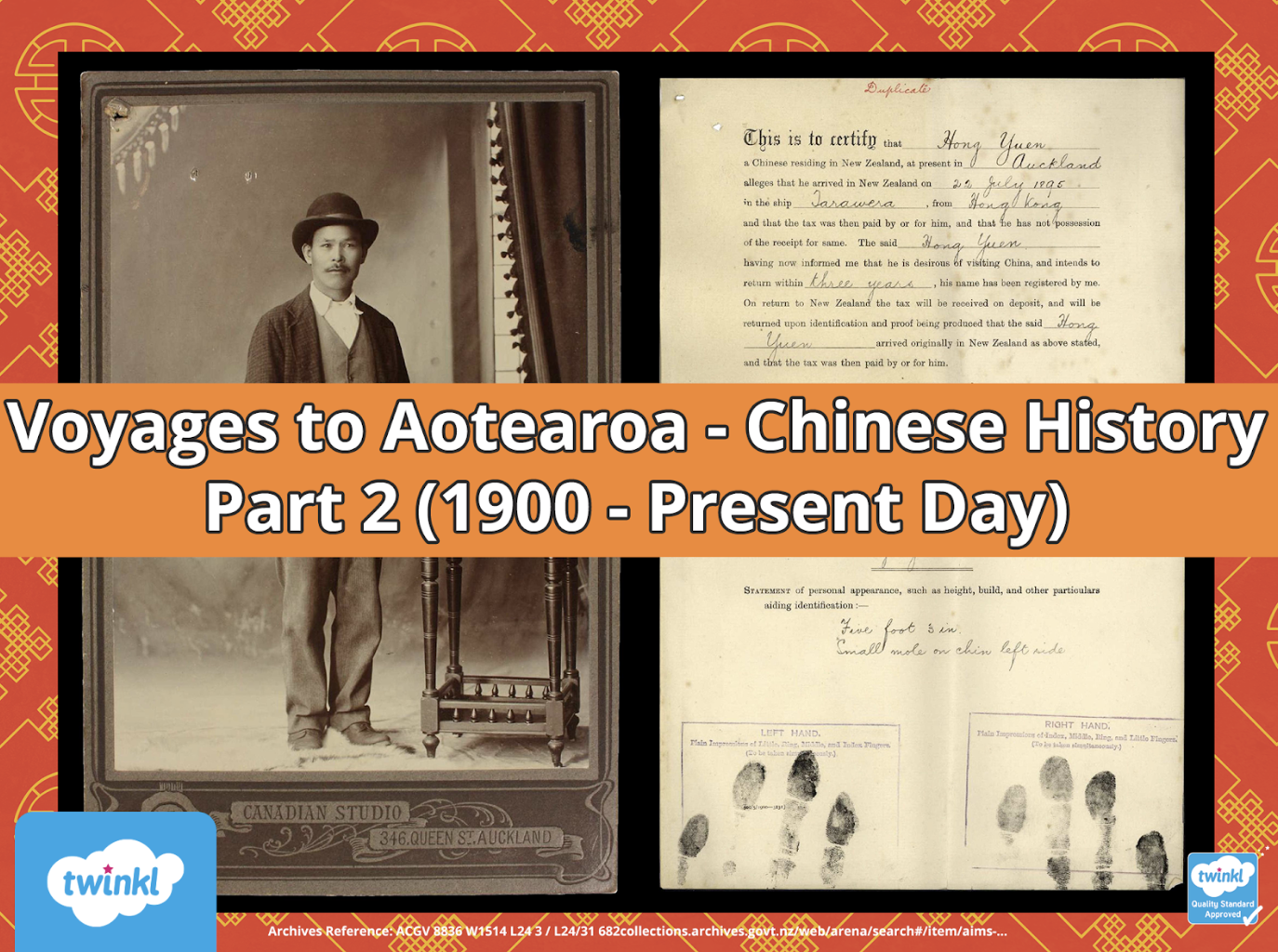
Voyages to Aotearoa - Part 2
Chinese history
See Google Classroom for resources and slide show.
-
FOCUS / ARONGA learning intentions:
- We are FOCUSING on inclusion and exclusion in Aotearoa by identifying historical immigration practises and laws in Aotearoa
- We are FOCUSING on inclusion and exclusion in Aotearoa by discussing the cultural ideals and economic values that shaped immigration laws
- We are FOCUSING on inclusion and exclusion in Aotearoa by describing the impact of these laws on migrant groups to New Zealand
- We are FOCUSING on inclusion and exclusion in Aotearoa by comparing how different groups were included and excluded from decision making
- We are FOCUSING on inclusion and exclusion in Aotearoa by explaining how groups have reacted to unfair laws and the outcomes they achieved through their efforts

Digging Deeper - What caused the Dawn Raids
Task: Summarise this section of text in 5 key words
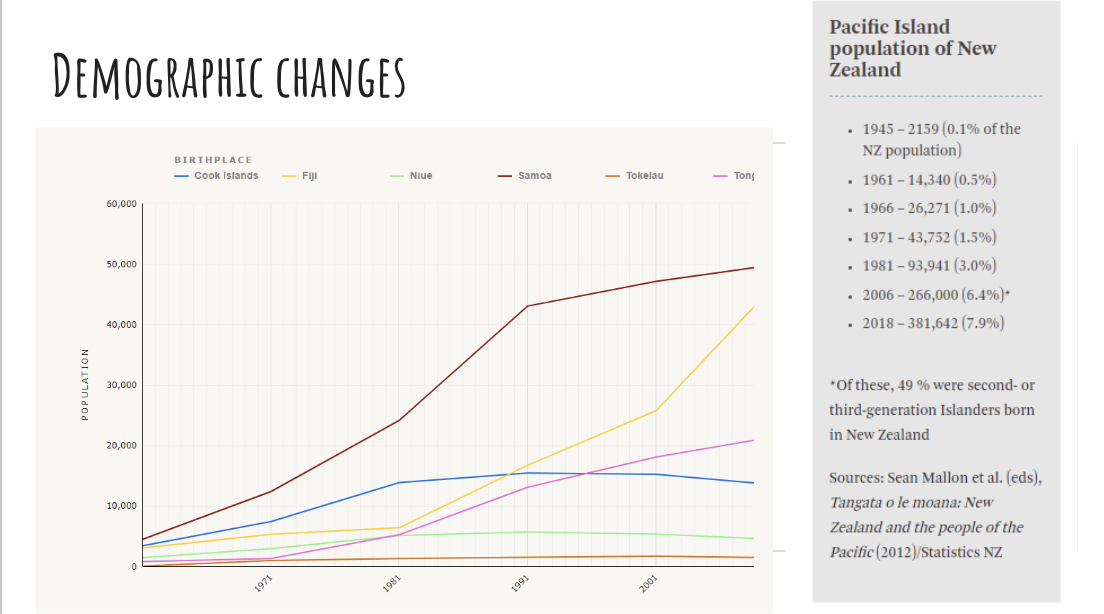
Task: Using the information on the previous slide to complete the questions below
Provide three pieces of information you can learn about Pacific migration to New Zealand since WWII
Using evidence from the table and/or graph, explain the changes of the Pacific Island population of New Zealand from 1945 to 2018
Explain the relationship between this data and the information on the previous slide
What does the term “second - or third- generation” mean?
-
FOCUS / ARONGA learning intentions:
- We are FOCUSING on inclusion and exclusion in Aotearoa by identifying historical immigration practises and laws in Aotearoa
- We are FOCUSING on inclusion and exclusion in Aotearoa by discussing the cultural ideals and economic values that shaped immigration laws
- We are FOCUSING on inclusion and exclusion in Aotearoa by describing the impact of these laws on migrant groups to New Zealand
- We are FOCUSING on inclusion and exclusion in Aotearoa by comparing how different groups were included and excluded from decision making
- We are FOCUSING on inclusion and exclusion in Aotearoa by explaining how groups have reacted to unfair laws and the outcomes they achieved through their efforts
Lesson 1
Watch the advertisement and write a TEXAS paragraph answering the 3 questions on slide 2This advertisement for the National Party, prepared by the American cartoon firm Hanna-Barbera, was played during the 1975 election campaign. It reflected an increasing hostility to immigrants from the Pacific as unemployment rose in New Zealand following the 1973 oil crisis.
Task: After watching the video, answer the questions below
This advertisement shows racist stereotypes of Pacific Islanders. What racist stereotypes are evident in this advertisement?
Why do you think the National Party would have released this advertisement? What were they hoping to do? Why do you think they believed this strategy would work?
What do you think the impact of this advertisement would have been on immigrants from the Pacific at the time? How might they have felt?
Lesson 2Watch the video from Spinoff and write a short explanation about how the pen highlighted the racism faced by Pasifika peoples in the 1970s.Black Panthers and Polynesian Panthers.
Task: Find out 5 key facts about the Black Panthers and what they were protesting for.
Look at the images of the Polynesian Panthers on Slide 6 and complete the tasks below.
Task 1: What similarities do you see between the images of the Polynesian Panthers and the Black Panthers?
Task 2: Why do you think activists wanting to protest the Dawn Raids modeled themselves on the Black Panthers?
Task 3: Select one of the photographs. What can you see. If you were there, what sounds might you hear? If you were a reporter, whom would you want to interview? What questions might you ask?
Task 4: Imagine you are a member of the Polynesian Panthers - write a diary entry explaining your motivations for protesting and what change you hope your actions will bring. Make sure you support your ideas with historical evidence.
Other Apologies
Task 1: What other formal apologies has the New Zealand government/crown made to groups of people and/or for specific events?
Task 2: For one of the apologies you have identified above, write a short paragraph explaining what actions the government had taken historically that saw them needing to make a formal apology.
-
Enter text here...
EXPLORE / TŪHURA learning intentions:
- We are EXPLORING biodiversity by investigating why our oceans are important
- We are EXPLORING the land and ocean by comparing ways in which we interact with the oceans
- We are EXPLORING the oceans and sustainability by researching the impact humans have on the marine reserves.
- We are EXPLORING the oceans and sustainability by identifying different ways we can sustainably use or interact with the oceans
Enter text here...
Enter text here...
LESSON 1: IMPORTANCE OF SEA TO US
FOCUS QUESTION: Why is the sea important for me? How am I connected with the sea?
• DISCUSS whakapapa & connectedness to sea according to te ao Māori
• SHARE recent connections with the sea & kai moana
• EXPLORE importance of the sea to us [slide 10]. Extend learning using true false cards
• READ National Geographic Resource Library: ‘Ocean’ and complete Kahoot QUIZ
• CATEGORISE different sea creatures and types of kai moana using Ocean Connection Cards & complete VENN DIAGRAM activity
• TEST & GROW knowledge of te reo Māori & English marine life names using the Sea Creature / Kararehe o te wai Cards and Kahoot
• RECORD & GRAPH favourite kai moana
• READ Whaitere – the enchanted stingray or Whaitere – te whai ātahu story & explore idea of kaitiakitanga.
Whaitere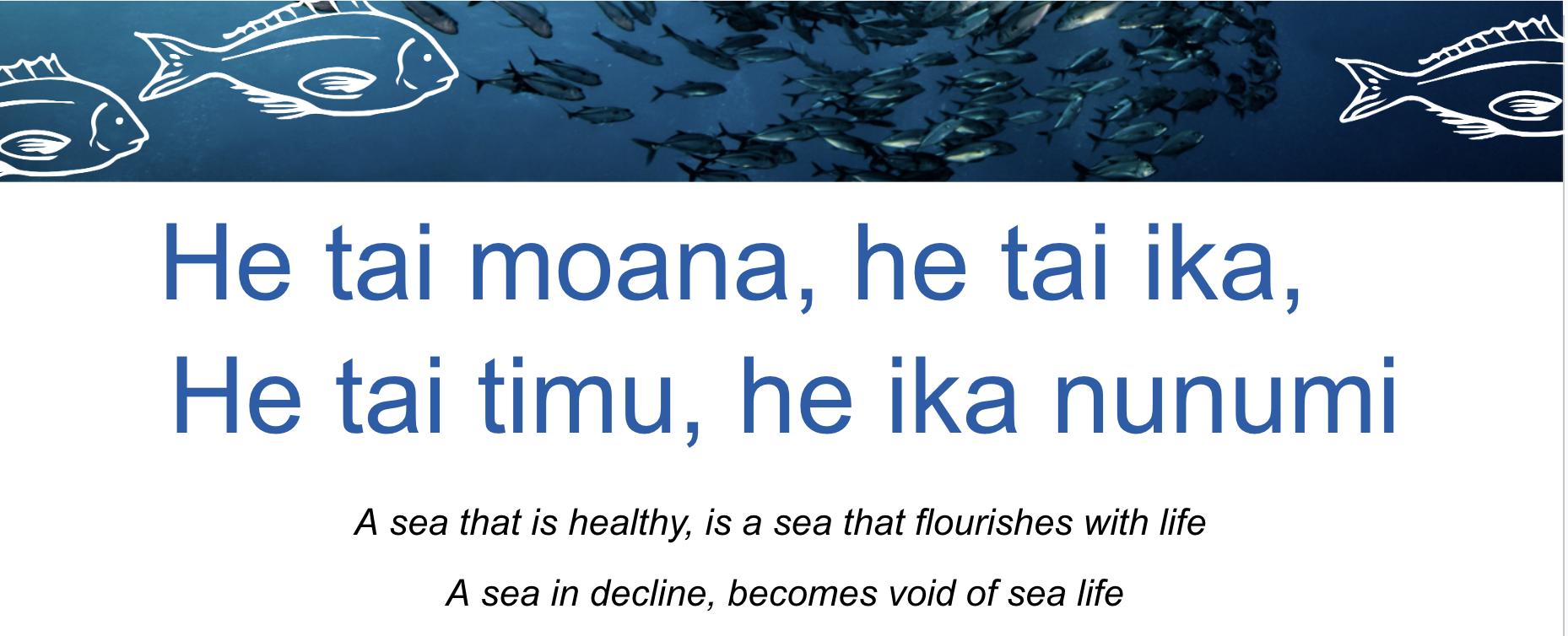
Take a Kahoot QUIZ
LESSON 2: OVERFISHING
FOCUS QUESTION: What is overfishing? What impact does overfishing have?
• DISCUSS impacts of overfishing
• Use Overfishing cards (warm up picture & idea cards) to COMPARE a sustainably vs overfished ocean
• BRAINSTORM what we already know about overfishing
• WATCH a short film made by Alice Guerin ‘Glad to Sea You’re on Board’.
• CONSIDER reasons why fish and marine life have declined
Add new knowledge to Overfishing Prior Knowledge Chart.
• DEFINE key terms, explore definitions and how overfishing affects population sizes.
• WRITE definitions of key terms (fishery, sustainable fishing, overfishing…)
• CREATE a diagram showing how overfishing affects the size of a fish population -
Enter text here...
EXPLORE / TŪHURA learning intentions:
- We are EXPLORING biodiversity by investigating why our oceans are important
- We are EXPLORING the land and ocean by comparing ways in which we interact with the oceans
- We are EXPLORING the oceans and sustainability by researching the impact humans have on the marine reserves.
- We are EXPLORING the oceans and sustainability by identifying different ways we can sustainably use or interact with the oceans
LEARNING Objectives
• Describe who the Marine Stewardship Council are, and what they promote
• Explain the meaning of the Marine Stewardship Council’s blue fish tick label
• Use scientific and fisheries related vocabulary
1. INVESTIGATE who are the Marine Stewardship Council are and what does the blue fish tick label mean?
2. WATCH the short film about the blue fish tick label [0:48]
https://youtu.be/Kac1cqkjX1U?feature=shared
3. WATCH the short film about the Marine Stewardship Council and sustainable fishing [1:30]
https://youtu.be/3rVeSBdpO6Q?feature=shared
4. Learn more about why we need the Marine Stewardship Council and the blue fish tick label using the Oceans at Risk worksheet and complete the Kahoot Quiz
OCEANS AT RISK WORKSHEET
Oceans are essential to life on Earth. They cover more than 70% of the planet's surface, regulate the climate, and supply the oxygen we need to survive. 34% of global fisheries are thought to be overfished
Map of the oceans
Source: Global Fishing Watch
The oceans are home to a huge variety of life. Much of this life is important to sustain people’s livelihoods (jobs) and ensure people have food to eat. Millions of people rely on fish as a source of protein. Seafood is one of our last major wild food sources.
The stakes are high when we consider how closely linked the health of our oceans is to our environmental, social and economic wellbeing.
The percentage of fish stocks that are within biologically sustainable levels have decreased from 90 percent in 1974 to 65.8 percent in 2017
It is believed that 34% (that’s about one third) of global fisheries have been fished beyond sustainable limits. And ironically it’s estimated that a third of fish is lost or wasted each year, as it travels from the ocean to our plates
Key factors contributing the problem are overfishing, illegal and destructive fishing as well as climate change and pollution. It’s not just the loss of marine creatures and environments, the problem has a serious impact on communities.
What is the Marine Stewardship Council doing?
The Marine Stewardship Council works with fisheries, scientists and industry to make sure our oceans are fished sustainably and it’s easy to find and buy certified sustainable seafood. Sustainable seafood is seafood that is caught in such a way that it can continue being caught for generations to come. Fisheries that are certified as sustainable are can display the Marine Stewardship Council blue fish tick label.
Test your knowledge: Answer the questions (next page) and then take the Kahoot “MSC Oceans at Risk” Quiz
Read more: Read WWF’s Living Blue Planet Report
Create your own map: Draw your own ocean map or create using scribble maps
Questions
How well did you read?
(1) Oceans cover more than _____ of the planet's surface, regulate the ________, and supply the oxygen we need to survive.
a. 70%, climate
b. 40%, sunshine
c. 10%, tides
d. 5%, moon
(2) ____ of fisheries are thought to be overfished.
a. 10%
b. None
c. 33%
d. 1%
(3) Seafood is our last major _______ food source.
a. Saltwater
b. Wild
c. Freshwater
d. Harvestable
(4) The size of marine populations has declined by ________ between 1970 and 2012.
a. 1%
b. Hardly any
c. A little bit
d. Almost half
(5) Key factors contributing the problem are
[Tick the correct answers]
a. Overfishing
b. Illegal and destructive fishing
c. Climate change
d. Pollution
(6) The Marine Stewardship Council works with fisheries, scientists and industry to make sure our oceans are fished _______________.
a. Sustainably
b. Unsustainably
c. Too much
(7) Fisheries that are certified as sustainable are given a _______ Marine Stewardship Council label.
a. Green
b. Red
c. Orange
d. Blue
Sustainable Fishing
Sustainable fishing means leaving enough fish in the ocean so that fish stocks remain healthy, looking after places where fish live [habitats] and ensuring people who fish can keep fishing.
LEARNING Objectives
• Explain ‘sustainable fishing’ and how it impacts on people and environments
• Use scientific and fisheries related vocabulary
1. DISCUSS what sustainable fishing means (according to the Marine Stewardship Council)
2. WATCH the award winning Marine Stewardship Council film My Dad the Fisherman [14:46] and
complete the Kahoot QUIZ
https://youtu.be/OIsA8xQ7WbQ?feature=shared
3. EXPLORE more deeply some fishing practices that are not examples of sustainable fishing. WATCH the short film [1:00] about bycatch and how it can be managed.
https://youtu.be/_3od7CqoQfs?feature=shared
4. Using the Unsustainable fishing cards. NOTE: In this activity we explore examples of unsustainable fishing to develop understanding about what exactly is and isn’t sustainable fishing!
5. INVESTIGATE how the Marine Stewardship Council deals with unsustainable practices
6. EXPLORE what sustainable fishing looks like in Aotearoa NZ and CONSIDER what you do to look after the sea.
7. CONSIDER the three principles used by the Marine Stewardship Council to determine sustainable fishing.
Reviewing Key Concepts
8. Review the entire Overfishing and Sustainable Fishing Topic using the summary quiz on Kahoot
9. Create an ANIMATION to convey the story of sustainable fishing making sure that key terms from Key Term Worksheet are included.
-
EXPLORE / TŪHURA learning intentions:
- We are EXPLORING to analyse the causes and consequences of the Great Pacific Garbage Patch.
- We are EXPLORING to critically consider New Zealand's role and responsibility in contributing to solutions
- We are EXPLORING informed perspectives on sustainable practices to reduce plastic pollution.
Great Pacific Garbage Patch
Most people think of the Pacific Islands as an island getaway, however, floating out in the Pacific Ocean is an environmental disaster. The Great Pacific Garbage Patch GPGP. is a collection of debris in the North Pacific Ocean.
What is GPGP?It has been created by the natural and tidal movement of the oceans and the vortex created has produced perfect conditions to collect the rubbish in an area. Once rubbish has entered the GPGP it is likely to never leave - the debris includes but is not limited to plastic, fishing gear, shoes and microplastic.
Ghost FishingAn estimated 705 000 tons of fishing nets are floating in the GPGP - this is known as ghost fishing. An estimated 54% of these nets come from North America and Asia and 20% from boats, cargo ships and offshore oil rigs.
There are an estimated 80 000 tonnes of rubbish in the GPGP - this is equivalent to 500 Jumbo Jets There are an estimated 250 pieces of rubbish for every human on the planet in the GPGP.
The Eastern Garbage Patch
The Eastern Garbage Patch is located off the coast of the USA in the area between California and Hawaii. It is estimated to be 1.6 million km? - about three times the size of France. Not all of the debris is floating on the surface - in some places it can be several metres below the surface. It was discovered by Charles Moore in 1997 when he was competing in a yacht race. Moore has been back numerous times over the years and is actively involved with Algalita Marine Research and Education, who in 1999 focused on reducing plastic use and protecting the oceans.
When Moore went back in 2014, he estimated that the problem was 100 times worse and now plastic features or 'islands' up to 15 metres in length are floating in the space.
PlasticsThe mass production and use of plastic occurred for the first time in the 1950s. Plastic is relatively cheap to make, it is malleable - so you can shape it easily - and it's durable.
Plastic is not biodegradable but can be broken down into smaller and smaller pieces in a process known as photodegradation.
Marine life is greatly affected by the GPGP. Marine animals that enter the GPGP are lucky to escape alive.
Rubbish
The rubbish is also blocking the sunlight that plankton requires to produce its own nutrients, resulting in an important food source for many sea life being destroyed. The plastic also leaches harmful pollutants into the water which are absorbed by the marine life living there.
ASSESSMENTOne of the issues that is being faced by the people and groups trying to clean up the mess, is that countries are not prepared to take responsibility for the problem and are not willing to help with the solution.
"Unless someone like you cares a whole awful lot, Nothing is going to get better. It's not"
- Dr Seuss (The Lorax)
There are some people and groups who are making the commitment to clean up the mess that has been created.
Your task is to create a Powtoon / Animation that can be used in campaigns raising awareness of the issue. Include the following in the brochure.
a. Who are they? Where are they from? How old are they? etc.
b. How did they get involved in cleaning up the GPGP?
c. What actions have they taken or are taking to try to solve the issue?
d. What can people do to support their campaign?
e. What difficulties are they facing?
F. Give one quote from them that sums up their actions or beliefs.
-
Enter text here...
REFLECT / WHAIWHAKAARO learning intentions:
- We are REFLECTING on the Great Pacific Garbage Patch and incorporating our knowledge of MSC Sustainable Fishing to create a POWTOON or animation to promote sustainable fishing and the preventation of overfishing of our oceans.
Enter text here...
We are working on our Assessment in Google Classroom.
Please add all research to Google Classroom and confirm submission on MHOL.
-
Enter text here...
REFLECT / WHAIWHAKAARO learning intentions:
- We are REFLECTING on the Great Pacific Garbage Patch and incorporating our knowledge of MSC Sustainable Fishing to create a POWTOON or animation to promote sustainable fishing and the preventation of overfishing of our oceans.
Enter text here...
We are working on our Assessment in Google Classroom.
Please add all research to Google Classroom and confirm submission on MHOL.
-
Enter text here...
EXPLORE / TŪHURA learning intentions:
- We are EXPLORING the aftermath of WW1 by recognising the challenges facing Germany after WWI
- We are EXPLORING the rise of the Nzazi’s and antisemitism by investigating the historical factors and societal conditions
- We are EXPLORING the Holocaust by researching its causes and effects on individuals, communities and nations.
- We are EXPLORING the aftermath of WW1 by recognising the challenges facing Germany after WWI
- We are EXPLORING responses to Nazism and antisemitism by analysing the reactions of different groups over time, including resistance movements, bystanders and collaborators.
- We are EXPLORING historical narratives and perspectives by interpreting various kinds of sources such as primary documents, survivor movements, bystanders and collaborators.
Enter text here...
Franco-Prussian War
• To describe the outcome of the Franco-Prussian War.
• To understand the terms and the consequences of the Treaty of Frankfurt.
Learning Objective: To understand how the Franco-Prussian War led to the First World War.
Students are shown a picture of two blocks and asked to think what the blocks might represent (‘power blocks’).
Work in pairs to discuss how they think the Franco-Prussian War could have led to the First World War. Then, share their ideas with other groups around the class. Try to encourage debate and discussion about how a defeated country might feel and what they and other countries might do to protect themselves. Ask students to evaluate each other’s ideas and decide which they think are most likely/convincing. Use the Think-Pair-Share Activity Sheet to facilitate this task.
Franco-Prussian War
Students will be asked to read the information on the slide as a class. Check their understanding by asking the Learning Check questions and give plenty of opportunity for students to ask questions.
The Treaty of Frankfurt
Explain the Treaty of Frankfurt to students and using the Treaty of Frankfurt Activity Sheet ask them to create a spider diagram outlining the terms of the Treaty of Frankfurt and the possible consequences. Students can also refer to the Franco-Prussian War Editable Notes to help with this task.
The Path To War
Ask students to think about everything they have learned and add to their ideas about how the Franco-Prussian War could have led to the First World War. Read through the information on the slide together, again allowing time for debate and questions.
Complete worksheets in Google Classroom
3.-The-creation-of-the-German-Empire.docx
4.-The-Franco-Prussian-War.docx
5.-Describe-two-features-writing-frame.docx
-
Enter text here...
EXPLORE / TŪHURA learning intentions:
- We are EXPLORING the aftermath of WW1 by recognising the challenges facing Germany after WWI
- We are EXPLORING the rise of the Nzazi’s and antisemitism by investigating the historical factors and societal conditions
- We are EXPLORING the Holocaust by researching its causes and effects on individuals, communities and nations.
- We are EXPLORING the aftermath of WW1 by recognising the challenges facing Germany after WWI
- We are EXPLORING responses to Nazism and antisemitism by analysing the reactions of different groups over time, including resistance movements, bystanders and collaborators.
- We are EXPLORING historical narratives and perspectives by interpreting various kinds of sources such as primary documents, survivor movements, bystanders and collaborators
The Alliances
Learning Outcomes• To describe the alliance systems that developed across Europe.
• To explain the consequences of the alliance systems.
Starter
Students will be shown a source that shows a newspaper cartoon of the alliance system. Students will be asked to think about the 5 Ws to work out what the cartoon is telling the reader. There is also an activity sheet with more detailed questions about the source available.
Main Activities
The Alliance System
The class reads the information about the alliances formed in Europe, discussing any of the key points as they go along.
The Alliance System Activity Sheet
Students can complete this activity in small groups or as individuals. They should use the information provided to fill in the gaps on the activity sheet.
Making Links Activity
Students complete this task using the fact sheet. They create links between the countries to show how they have been connected by agreements and disagreements.
Plenary
Arrange the 6 countries into alliances to try and avoid a war. Students will be asked to discuss their choices with the class.
-
Enter text here...
FOCUS / ARONGA learning intentions:
- We are FOCUSING on [changing views on conflict] by defining Aotearoa’s national identity and identifying how it has changed over time
- We are FOCUSING on [changing views on conflict] by discussing New Zealand’s involvement in WWI
- We are FOCUSING on [changing views on conflict] by explaining New Zealand’s involvement in the WW1
- We are FOCUSING on [changing views on conflict] by describing ANZAC day and comparing it with ways we commemorate other conflicts as a nation
- We are FOCUSING on [changing views on conflict] by comparing Aotearoa’s involvement in international conflicts over time and how they are commemorated
Enter text here...
Enter text here...
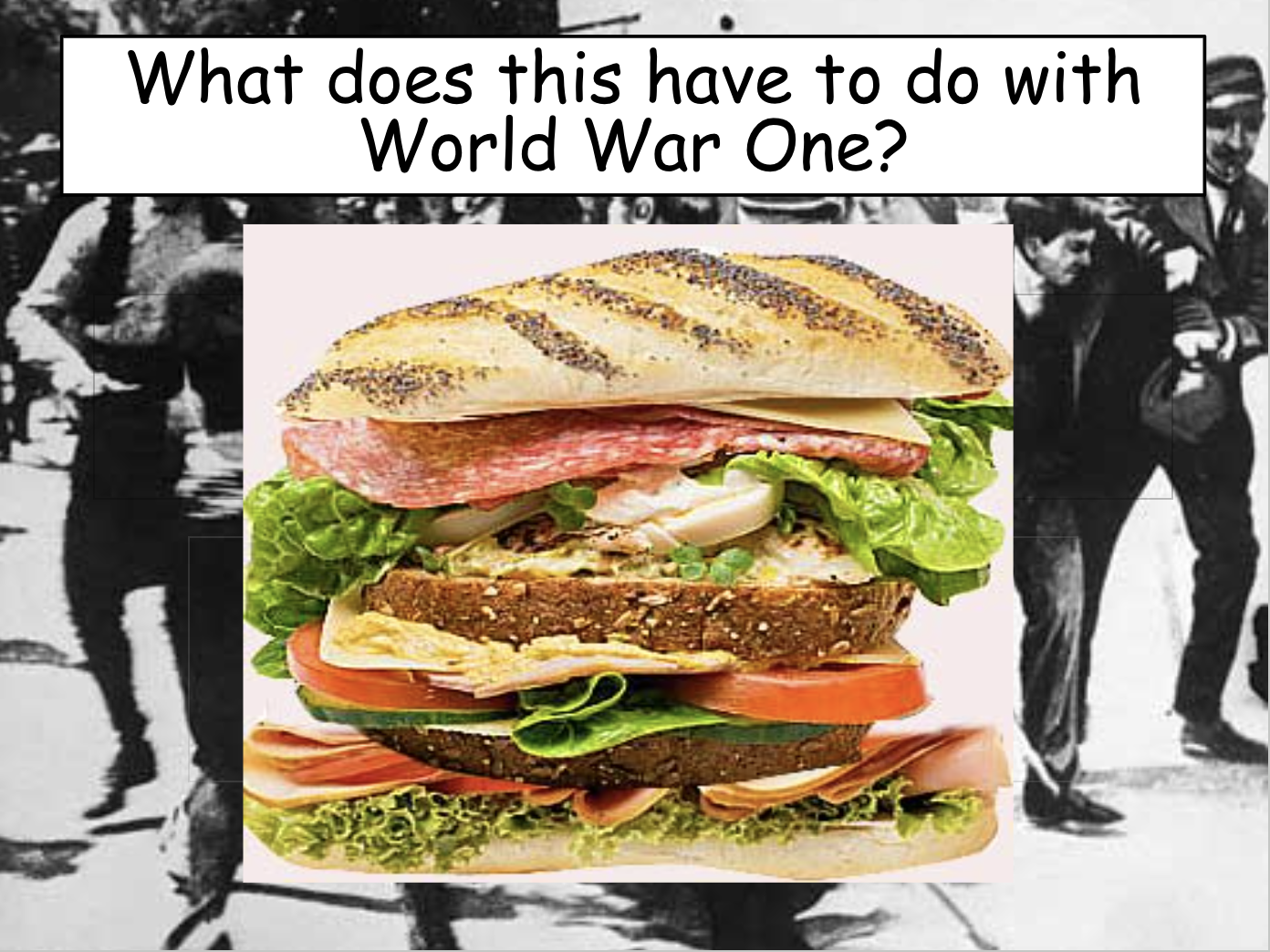
Following up from last week's lesson
Learning Intentions:
- To describe the assassination of Archduke Franz Ferdinand.
- To predict how his assassination led to World War One.
Answer these questions
- Who assassinated the Archduke?
- Where did this happen?
- Was this part of the plan?
- Come up with some 'what if's'
Franz Ferdinand arrived in Sarajevo on 28 June 1914, a Sunday, and was met at the railway station by General Potiorek, to be taken on to the City Hall for the reception and speeches.
Seven members of the Black Hand lined the route due to be taken by the Archduke's cavalcade along Appel Quay. One of the men, Nedjelko Cabrinovic, threw a grenade at the Archduke's car. The driver took evasive action and quickly sped from the scene. The grenade bounced off the back of the Archduke's car and rolled underneath the next car, exploding seconds later; two of its occupants were severely wounded.
Cabrinovic swallowed his cyanide capsule as instructed, and jumped into the River Miljacka. He did not die however, but was captured and arrested. Ferdinand attended the reception at the city hall and complained about his treatment in the city.
Following the reception the Archduke decided to visit those injured in the grenade explosion at the city hospital. General Potiorek decided that the motorcade should take an alternate route to the hospital, avoiding the city centre altogether. However the driver of Ferdinand's car, Franz Urban was not informed of the change of plan and so took the original route.
Turning into Franz Josef Street General Potiorek, who was a passenger in Ferdinand's car, noticed that the altered route had not been taken. He argued with the driver who in turn slowed the car and then began to reverse out of the street.
Gavrilo Princip who happened to be in Franz Joseph Street, buying a sandwich at a cafe, seized his opportunity, and took aim at Ferdinand from a distance of five feet. His bullets struck the Archduke in the neck and his wife, Sophie, who was travelling with him, in the abdomen.
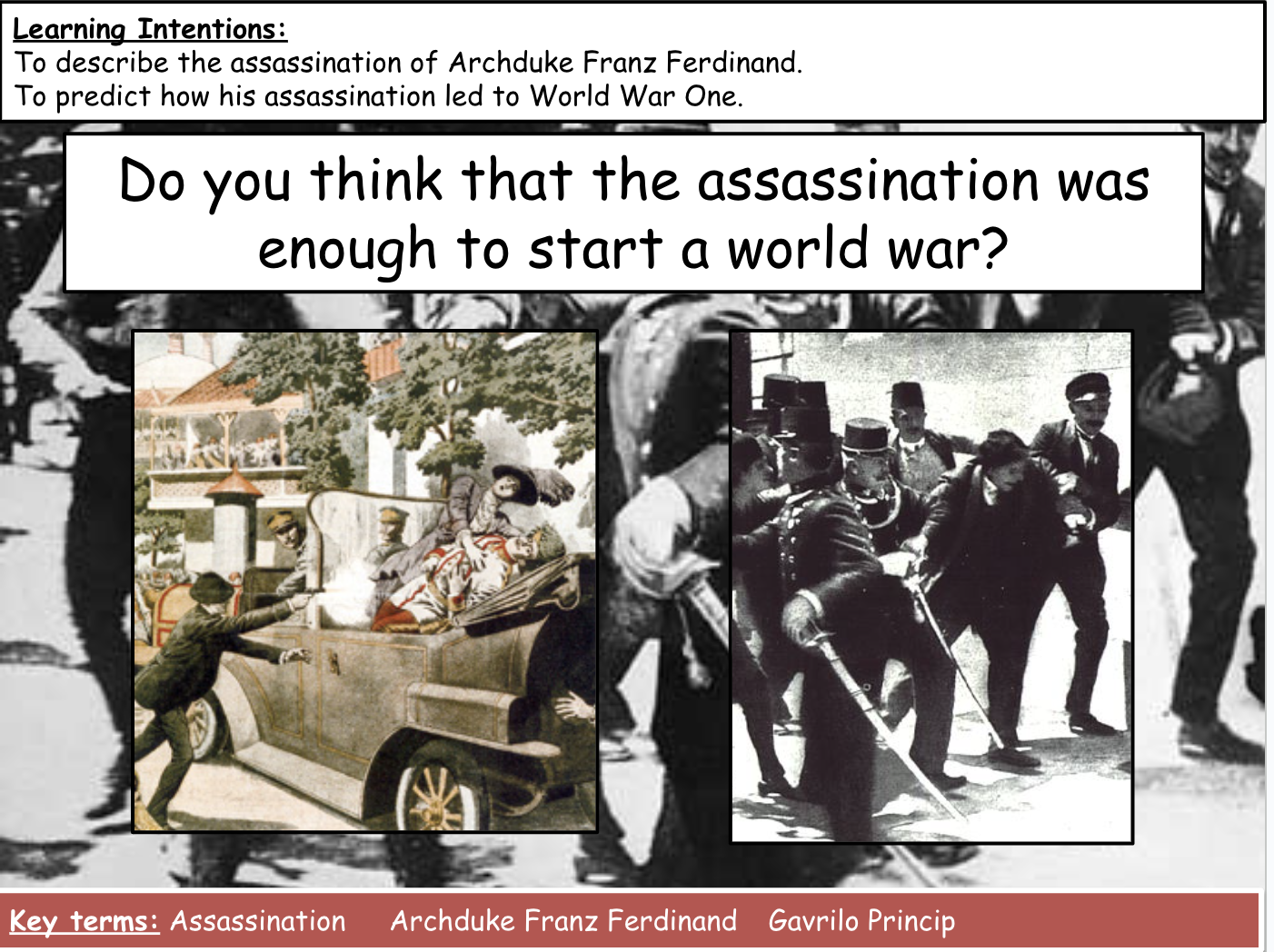
Serbia was blamed by Austria for this murder. Serbia was near to Bosnia and it had encouraged the Black Hand Gang and given the gang weapons. Serbia hoped that both herself and Bosnia would unite to form a new state.
Austria decided that Serbia must be punished and planned to invade her. Serbia called on her old friend Russia to help her.
Serbia would have been easy for Austria to crush. Russia was a different issue. She had a huge army and Austria would not have coped with a Austro-Russian war. Austria called on Germany for help. The German government agreed to this and their response upset the French government.
However, unknown to anybody other than the German government, the German army had created a plan to defeat France in 6 weeks before fighting Russia.
This plan involved an attack on France via Belgium.
Britain had given Belgium a guarantee in 1839 that if anybody attacked her, Britain would attack the attacker.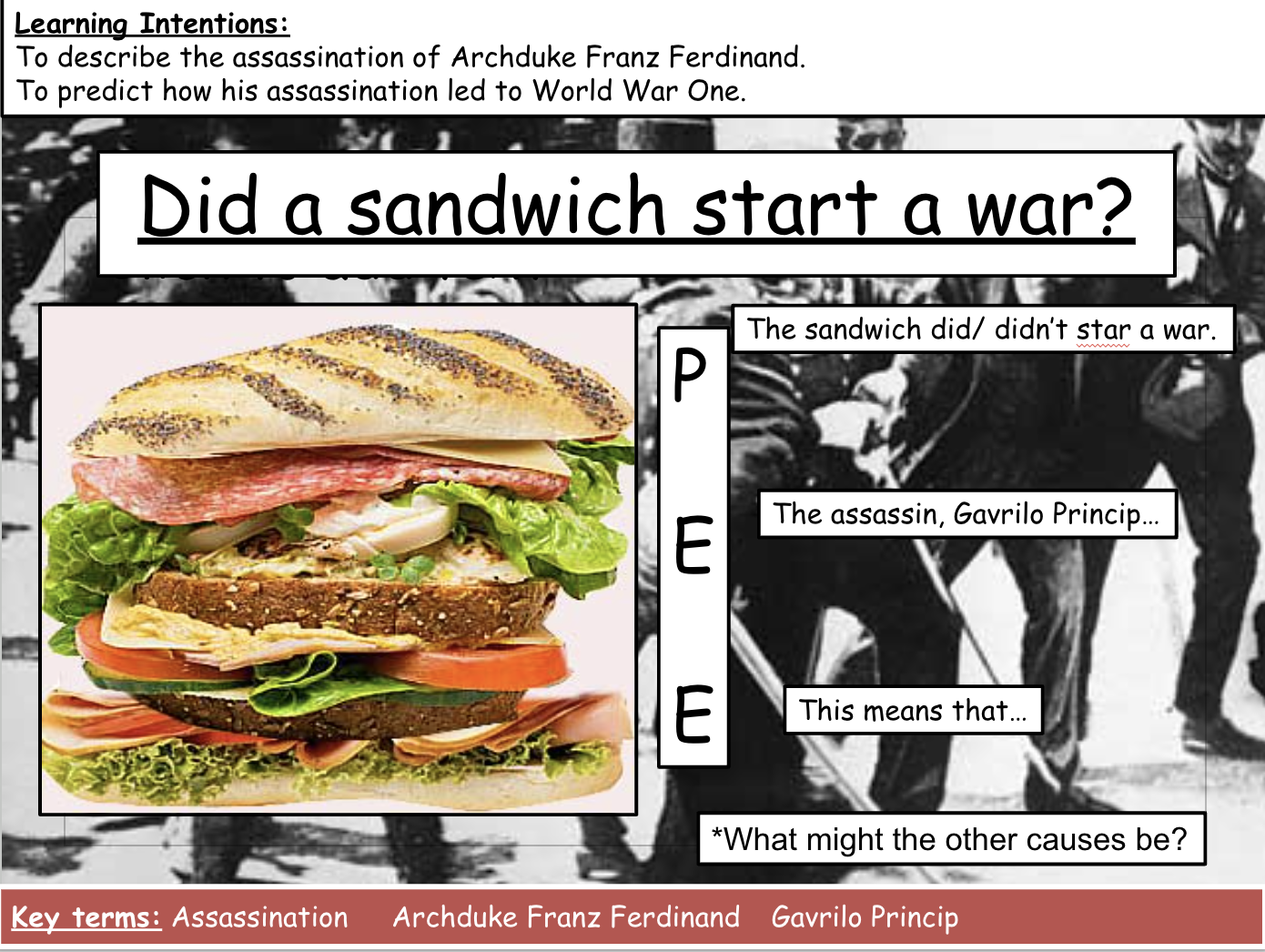
So lets review
How accurate is this statement:“The first world war broke out because of Germany’s acquisition of overseas colonies and the development of a large navy.”
Lets talk about Alliances

Review what we wrote about the quote last lesson.“The first world war broke out because of Germany’s acquisition of overseas colonies and the development of a large navy.”
By 1914 the most powerful countries in Europe were divided into two opposing Alliances.
Alliance: A union or association formed for mutual benefit
In your groups you have been given an information card for the main countries that were involved in World War One. Each of them were part of an alliance with countries that shared their ideas and could be counted as allies.
Task
You must decide what countries should form an alliance based on the information on the cards.
You will have to justify you answer.
The Triple Entente (French for agreement): this was between Britain, Russia and France.
- The Triple Alliance: This was between Germany, Italy and Austria Hungary.
Review the political cartoon
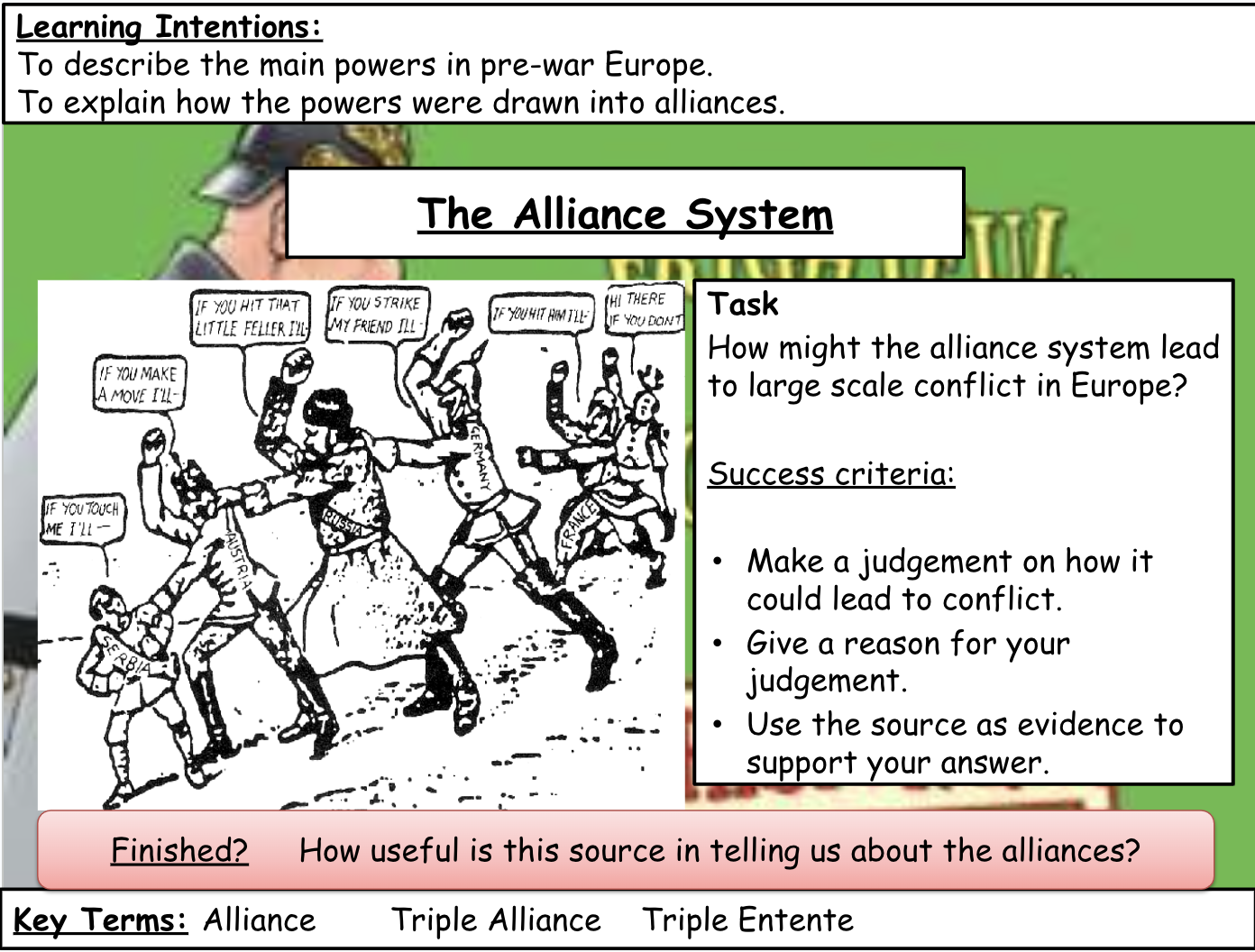
How could the alliance system cause a war?
-
Enter text here...
PLAN & DO / WHAKAMAHI learning intentions:
- We are PLANNING to understand NZ at War so that we can understand the level of participation of the Maori Battalion and NZ Women in wars.
Source Analysis
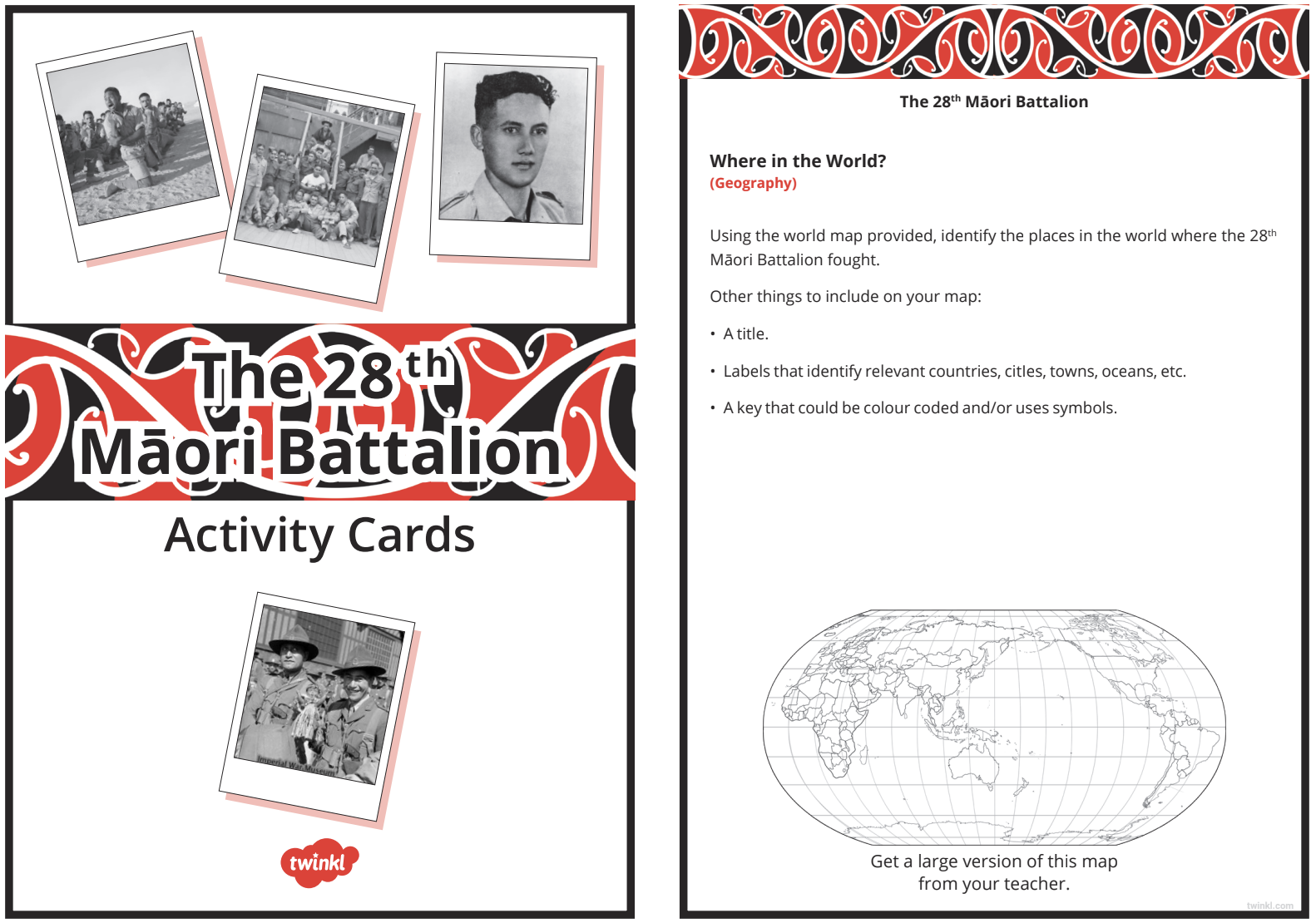
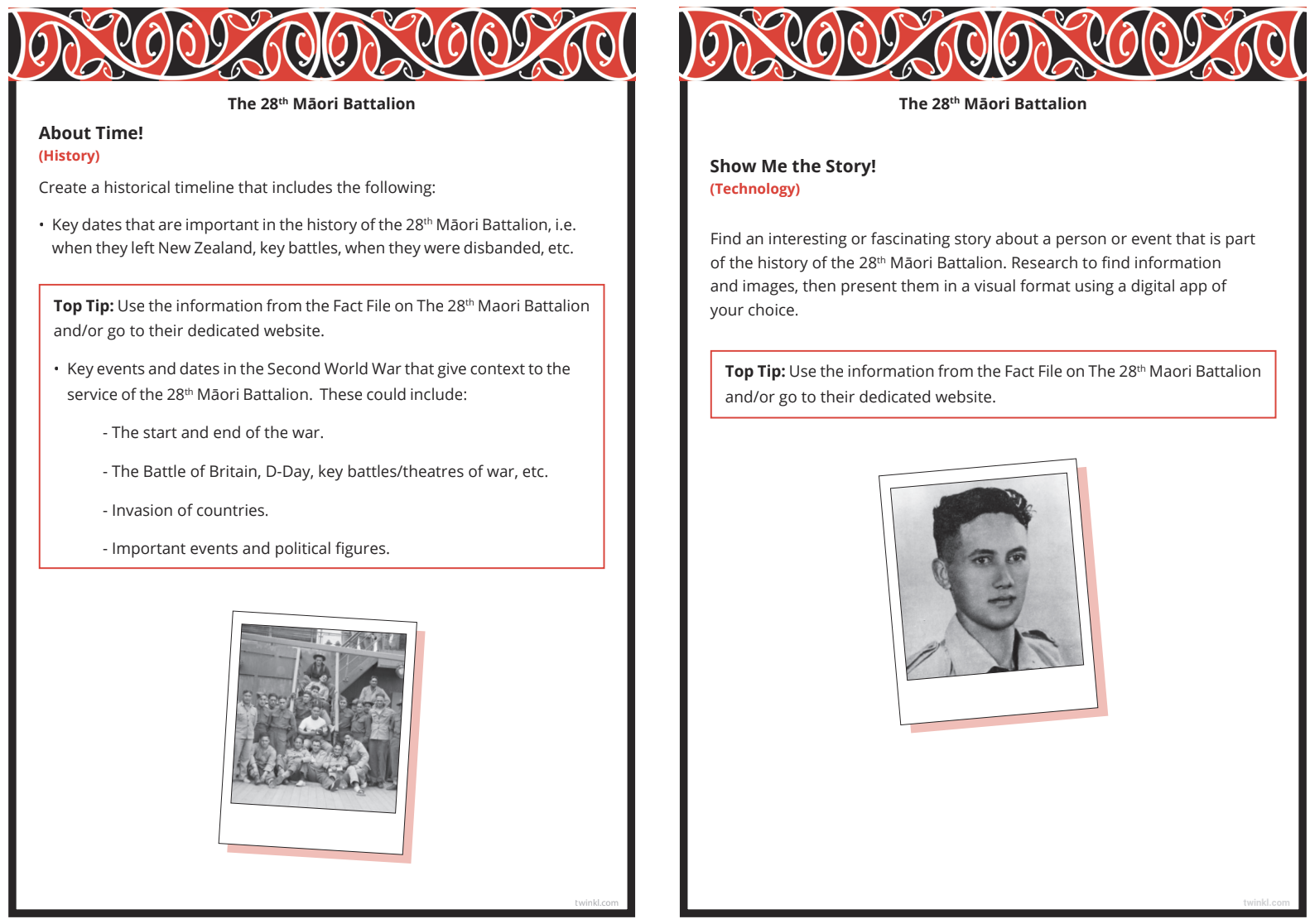
World War II: The Pacific Front
Part 1: Significant Terms: Instructions: In least one complete sentence each, describe the historical significance of the terms below in reference to the Pacific Front of World War II.
1. Isoroku Yamamoto:
2. Pearl Harbor:
3. James Doolittle:
4. Frank Fletcher:
5. Battle of Midway:
6. Hiroshima:
7. Nagasaki:
8. Hirohito:
Part 2: Short Answer: Instructions: In at least one paragraph each, answer the questions below.
1. Who was Douglas MacArthur? What impact did he have on the Pacific Front of WW II?
2. What role did J. Robert Oppenheimer and Albert Einstein have in World War II?
3. Describe what happened to Japan after they surrendered. Also, describe the aftermath of WW II and the way it impacted the world.
Use information below to complete the Source Analysis.
World War II: The Pacific Front
Japan was in the Axis Powers with Germany and Italy. President Franklin Delano Roosevelt (1882-1945) feared Japanese expansion in Asia. He tried to pursue measures to stop them. FDR gave aid to China to help them against Japan and cut off oil supplies to Japan. Angry at these actions, Japan assumed that, eventually, the USA would join the war. In a preemptive strike, Japan attacked American naval ships in Pearl Harbor in Hawaii. Over 2,000 Americans were killed. Admiral Isoroku Yamamoto (1884-1943) led the attack for Japan on December 7th, 1941.
The USA controlled the Philippines and Guam due to gaining these territories in the Spanish American War of 1898. By 1942, Japan had invaded these areas and took them from the USA. Likewise, Japan attacked the British controlled area of Hong Kong in China. They also took the Dutch East Indies. The Japanese aggressively were seeking to control all of Asia.
The Japanese were vicious toward the regions they conquered and especially toward the soldiers who resisted their occupation. This cruelty was particularly evident in the Japanese conquest of the Philippines, which was a territory of the USA. Their malice was chiefly made visible in The Bataan Death March of 1942. Tens of thousands of American and Filipino soldiers were taken as prisoners of war. The Japanese forced the soldiers to march down the Bataan Peninsula. During the march, the prisoners of war were physically beaten and abused. Thousands were also murdered during and after the march.
After Pearl Harbor, the USA joined the Allies and declared war on Japan and the Axis Powers. Their main military focus was on Hitler’s Nazi takeover of Europe. However, the USA wanted to prove they could strike back against Japan on its own mainland. On April 18th, 1942, Colonel James Doolittle (1896-1993) led an American bombing raid on Tokyo, taking out various military targets. This operation boosted the attitude of the USA because it proved to the world that Japan could be attacked in their own capital. It was called Doolittle’s Raid.
Japan had conquered various areas in the Pacific and turned next to Australia, in May of 1942. The Imperial Japanese Navy tried to take various areas in the Coral Sea, like New Guinea, as a launching pad for a full invasion of Australia. American naval fleets arrived to fight the Japanese and defend Australia.
In the Battle of the Coral Sea in 1942, Aircraft carriers played a major role in the conflict and its outcome. War Planes caused the vast majority of the damage to both the American and Japanese naval vessels. Admiral Shigeyoshi Inoue (1889-1975) led the Imperial Japanese Navy in its attempt to secure strong holds for a future Australian invasion. US Admiral Frank Fletcher (1885-1973) led a group of American and Australian forces to face off against the Japanese. The Battle of the Coral Sea was costly to both Japan and the team of American and Australia. Yet, it halted a full Japanese takeover of Australia.
In the Battle of Midway, one month after the Battle of the Coral Sea, in June of 1942, Japan sought to invade and control the island of Midway, the location of an American base. Japanese Admiral Isoroku Yamamoto (1884-1943), helped lead the attack for the Imperial Japanese Navy. Yet, American Admiral Chester Nimitz (1885-1966), resisted the attack and maintained the American strong hold. This was a massive victory for the Allies, because the Imperial Japanese Navy had to retreat. Four Japanese ships that had participated in Pearl Harbor were at Midway and were sunk by the Americans.
After the Battle of Midway, the Allies launched various offenses against Japanese strong holds in the Pacific. General Douglas MacArthur (1880-1964) led America and the Allies in these pursuits. MacArthur launched invasions to take the islands of Iwo Jima and Okinawa. In the Battle of Iwo Jima from February to March of 1945 and the Battle of Okinawa from April to June of 1945, the two islands were seized from Japan as the Allies then focused their attention to Japan’s mainland. Japan had overtaken a massive amount of the Pacific region. Yet, now, the Allies were bringing great defeats to the Japanese. In an attempt of desperation, the Japanese commanded their pilots to crash into Allied vessels. These pilots were called kamikazes. Even with these drastic measures, the Japanese could not halt the Allies progression against their nation.
What Japan did not realize was that a gargantuan secret development was taking place in the USA, code named the Manhattan Project. Led by J. Robert Oppenheimer (1904-1967), scientists built the first nuclear weapons, atom bombs. Helping them was a Jewish scientist who escaped Nazi occupied Europe, Albert Einstein (1879-1955). This was called the Manhattan Project. President Franklin Roosevelt died on April 12th, 1945 from natural causes, before the bomb was ready to use. Harry Truman (1884-1972) became President. He knew a land invasion of the mainland of Japan could cost millions of Japanese and American lives. Truman gave the command to force Japan to surrender by ordering atom bombs to be dropped on Hiroshima on August 6th, 1945 and Nagasaki on August 9th, 1945. The aircraft called the Enola Gay dropped the first atom bomb on Hiroshima. The attack was devastating instantly killing tens of thousands of Japanese citizens. It was the most powerful weapon ever used in warfare.
After the devastating atomic bomb attack, Japan surrendered. Now, Germany, Italy, and Japan, (the Axis Powers) were all defeated. General MacArthur met with Japanese leadership on the USS Missouri in Tokyo, on September 2nd, 1945, to sign the Japanese Instrument of Surrender Treaty. The Prime Minister of Japan, and mastermind of many military campaigns, Hideki Tojo (1884-1948), was eventually executed. Emperor Hirohito (1901-1989) was allowed to stay in power, but had to submit to all of the Allied demands for the future of Japan.
World War II, which saw the Allies battle the Axis Powers, forever changed the world. There were between 70 to 80 million casualties in the war, the highest of any war ever fought in history. Yet, the Allies were able to take down the Fascist regimes of Germany and Italy and halt the Japanese Empire’s stranglehold on the Pacific. The USA emerged as the most powerful superpower on earth, but a Cold War was on the horizon.
-
Enter text here...
EXPLORE / TŪHURA learning intentions:
- We are EXPLORING the animals involved in the wars and thier effect on World War I
Context of Lesson/Key Ideas:
The Centenary of the First World War is an ideal opportunity to look at the role of animals during this time. Animals played an extensive part in WW1. This lesson looks at which animals were used, and why.
Aims and Objectives:
• To explore the varied roles of animals during World War One.
• To research and report back on your findings.
Learning tasks:
• Brainstorm as a class what students already know about the use of animals in World War One.
Keep the list as a checklist for future reference.
Research
1. Search the resources on the Animal Aid website and compile a list of all the different kinds of
animals used by both sides in the war.
2. For each animal, make a list of all the different kinds of activities they performed.
3. Study sources 1 - 4 and comment on where the animals used in the war came from.
4. Use Resource sheet 4: Photos (5a, 5b and 5c) to report on how these animals were trained for their part in the war.
Resources (available as downloads from the Animal Aid website):
1 Photo of horses pulling a plough (Source 1)
2 Resource sheet 1: Letter from Freda to Lord Kitchener (Source 2)
3 Resource sheet 2: Photo of Betty (Freda’s horse) (Source 3a) and Lord Kitchener’s reply (Source 3b)
4 Resource sheet 3: Personal accounts (Sources 4a, 4b and 4c)
5 Resource sheet 4: Photos (Sourcs 5a, 5b and 5c)
-
Enter text here...
EXPLORE / TŪHURA learning intentions:
- We are EXPLORING the animals involved in the wars and thier effect on World War I
- We are EXPLORING historical narratives and perspectives by interpreting various kinds of sources such as primary documents, survivor movements, bystanders and collaborators.
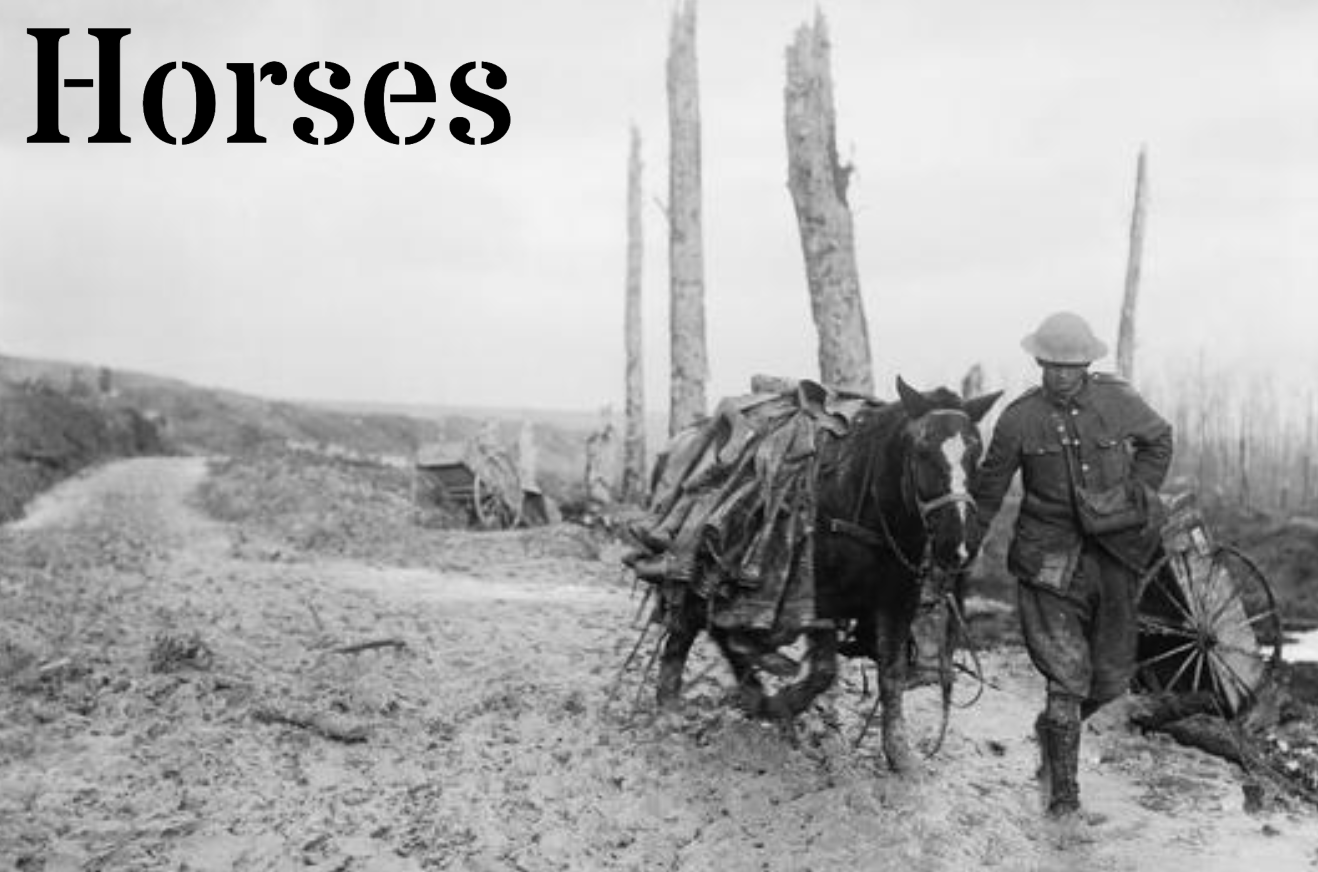
WAR HORSES ANIMALS IN WORLD WAR ONE - PART ONE
A mule team stuck in the mud during the battle of Passchendaele (IWM)
In the First World War, horses, mules and donkeys were considered vital to the war effort. They carried troops, pulled artillery and hauled supplies to and from the front. The animals experienced terrible hardships and many died from wounds, exposure, exhaustion and disease.
The call up
When war broke out, the British military, like all armies at the time, relied on horsepower. Motorised transport had only recently been invented, and the army, which had few lorries, relied on horses and mules to move troops and equipment.
In 1914, the army purchasing officers were sent to towns and villages to obtain more horses for the rapidly expanding military forces. Some horses were taken from farmers, hunt stables and businesses, but many were voluntarily sold to the government for use in the war effort. In just two weeks,140,000 horses were drafted into the army, to add to the 25,000 horses they already had.
The role of horses
Horses and mules in the British army in 1918
Source: BBC website - What was the Real Story of War horse?
ANIMAL AID INFORMATION SHEET ANIMAL AID INFORMATION SHEET
The Royal Scots Greys practising a charge
(National library of scotland)
Cavalry
On 13 August 1914, one division of cavalry and their complement of 25,000 horses set sail for France with the British Expeditionary Force (BEF). It was thought by many that they would be a decisive factor in the coming conflict.
It was not to be. Towards the end of the opening year of the war, the way the armies fought changed. On the Western Front in Europe, the two sides dug trenches and the short distance between them, called ‘No Man’s Land’, became a killing ground strewn with barbed wire, shell holes and dead bodies. Cavalry horses stood no chance against weapons such as machine guns, high-explosive shells and barbed wire.
On the few occasions that cavalry were sent charging into battle, they suffered terrible losses.
On 30th March 1918 during one of the last ever cavalry charges, the Canadian Cavalry Brigade was ordered to retake the German hilltop position on Moreuil Wood. Three Troops of the Royal Canadian Dragoons charged up the hill towards the German position into murderous machine gun fire.
The position was taken, but at great cost. Of the 150 horses who went into the fray, only four survived the charge. At the end of the day the Brigade had lost 300 men and more than 800 horses.
Charge of Flowerdew’s Squadron
Moreuil Wood, 1918
Painting by Alfred Munnings
Artillery
Horses were yoked in teams of three pairs to pull light field artillery, and as many as 10 pairs to haul heavy howitzer guns.
Early in the war, Royal Field Artillery (RFA) and Royal Horse Artillery (RHA) units fought forward with the infantry, close to the enemy where they sustained heavy losses. In these early battles, horses did not retire to relative safety, but stayed with the batteries (guns) during the engagements.
Artillery horse train pulling an 18-pounder field gun (IWM)
During the retreat from Mons in 1914, Captain Douglas Reynolds of the 37th Battery RFA wrote:
‘seeing that all the horses attached to a number of guns had been killed, we brought up two new teams in the hope of rescuing the guns. Driven by volunteers, and within a hundred yards of the enemy, the teams attempted to hitch up two guns to drag them away. Under a hail of fire, one whole team was shot down.’
Albert George, Artillery Sergeant, recalled:
‘We could see ammunition wagons trying to replenish, getting about half-way to the gun, then a couple of shells would burst blowing the drivers and horses to smithereens, it was a terrible sight...’
Hauling supplies
The majority of horses and mules were used by the Army Service Corps (ASC). They had the job of supplying water, food and ammunition to the troops at the front.
The ASC teams faced many hazards. The journey to and from the frontline could be fraught with danger. The enemy would frequently shell known key supply routes and junctions. Supplies had to get through, so men and horses had to risk their lives – often at night – running the gauntlet to supply the troops.
In the book A Call to Arms, Joseph Murray describes one such road:
‘There was no shelter at all over the newly captured ground. The road to Beaucourt was a graveyard of many of the ration parties that had attempted to get through to us. When we reached the village, it was a dreadful sight: mutilated bodies of men, horses and mules everywhere among which we had to shelter while waiting a chance to run the gauntlet known to us as ‘suicide corner’. The road, the only one, and the only way in or out of the area of our attack, had been in enemy hands for years and now they were free to concentrate all their fire on this narrow strip of activity.’
After heavy rainfall, the constant shelling turned the battlefield into a treacherous muddy swamp, which took the lives of many animals. Sidney Smith, a private, recalled his experience in 1916 on the Somme:
There was ‘nothing the eye could see except waves rippling the mud as the wind blew, I had the terrible experience to witness three horses and six men disappear completely under the mud. It was a sight that will live forever in my memory. The last horse went to a muddy grave, keeping his nostrils above the slush until the last second. A spurt of mud told me it was all over’.
3
A shell explodes near a team of artillery horses (IWM)
Galloping horses run the gauntlet at ‘hellfire corner’
(Source: Simon Butler)
Six-horse teams pulling general service (GS) wagons (Source: Simon Butler)
Bandaged horse at a British Army veterinary hospital (IWM)
Casualties
What happened to the horses when war ended?
There was no ‘heroes’ return’ for the majority of horses at the end of the war. Only those owned by officers were guaranteed to return to Britain. The fate of the others depended upon their age and fitness.
25,000 horses remained in the British army while between 60,000 and 100,000 were returned to Britain to be auctioned. The remainder were sold in the country where they were stationed at the end of the war – to farmers as work animals or to butchers to be killed for meat.
A fortunate few were rescued by the RSPCA and Blue Cross Fund and retired to live out their lives on sanctuaries.
Casualty rates were high. By the end of the war there were 1,300 veterinary surgeons in the British Army Veterinary Corps working in 20 veterinary hospitals.
725,000 horses were treated and three-quarters survived. Many were not so fortunate.
It is estimated that a total of 8 million horses, mules and donkeys lost their lives in the war.
Many animals were killed by shellfire, but most died from the terrible weather and appalling conditions. On the Western Front, the loss of British horses due to cold, hunger, exhaustion and disease was about
200,000 - four times more than the 58,000 killed by enemy action.
German horse-drawn ambulance hit by shellfire (Source: Simon Butler)
The Brooke Hospital for animals was founded by Dorothy Brooke (second from the left) to care for horses abandoned in Egypt after WWI.
Heroes or victims?
Some people say that the animals who saw action in the First World War were heroes because they were brave. Other people argue that the animals who died in combat were victims because they did not agree to take part in the war. What do you think?
War Memorial in Hyde Park, London, dedicated to animals who have died in war. The inscription says ‘They had no choice’.
Get into pairs or small groups and study the evidence provided by the various sources.
Sources are in Google Classroom. Sort it into groups that will help them answer the question:
What was the war like for horses during World War One?
Do you have enough evidence to answer the question. What else might you need to know?
Where might you find this information? Do you know any information about other fronts, not just the Western Front in France and Belgium?
Which three pieces of evidence in Google Classroom would you choose to answer this question. Why?
Write a TEXAS/PEEL paragraph to explain.
-
Enter text here...
EXPLORE / TŪHURA learning intentions:
- We are EXPLORING the animals involved in the wars and their roles and effect on World War I
- We are EXPLORING historical narratives and perspectives by interpreting various kinds of sources such as primary documents, survivor movements, bystanders and collaborators.
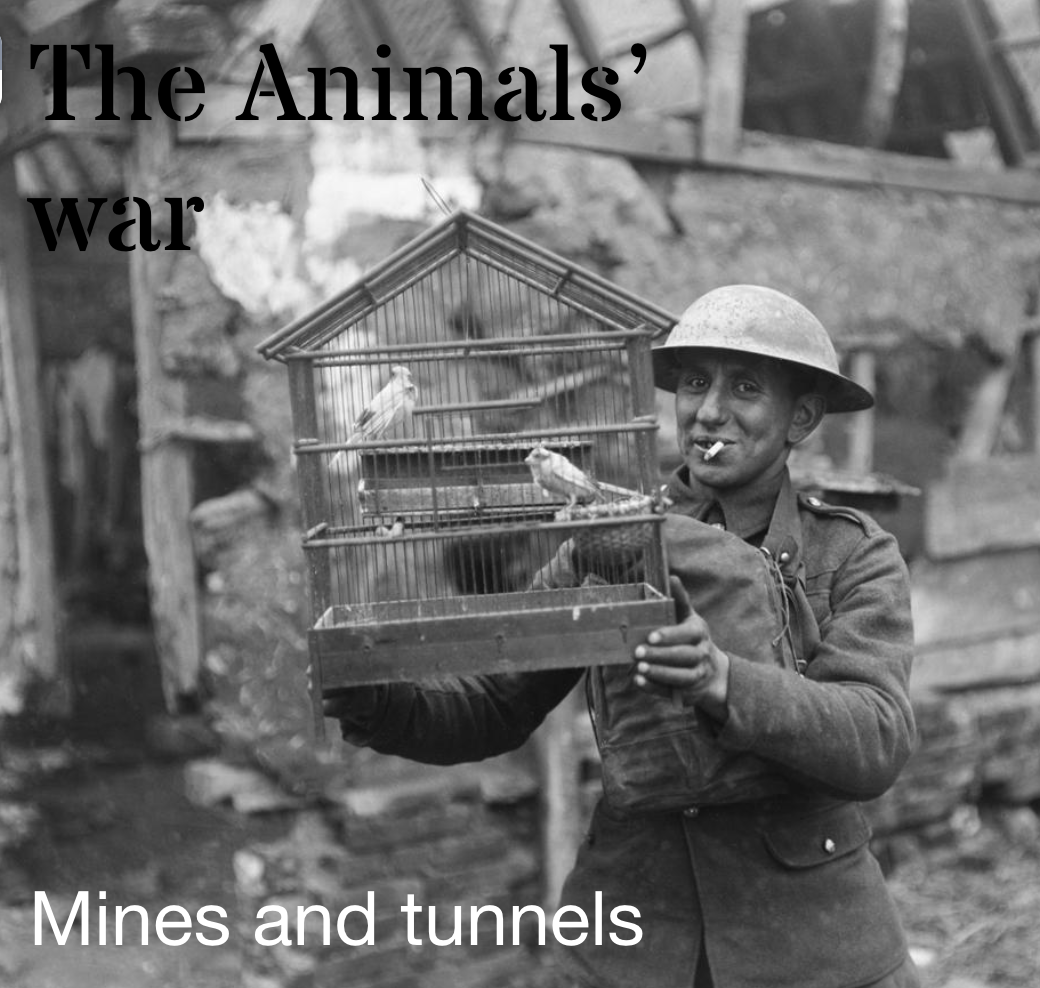
Context of Lesson/Key Ideas:
The Centenary of the First World War is an ideal opportunity to look at the role of animals during this time.
This lesson looks at the work of the tunnellers and the role played by canaries in subterranean warfare.
Aims and Objectives:
• Understand that both sides dug tunnels so that they could explode mines beneath the enemy’s trench systems.
• Know that soldiers fought underground – attacking the enemy’s trenches and defending their own.
• Know that canaries and mice were used (and often died) in the tunnels to give warning of poisonous gas.
Learning tasks:
• Watch film clip from YouTube: ‘One of our mines is missing!’
• Field suggestions as to what happened and what the cause may have been.
• Get into teams of three or four. Provide each team with a set of sources (a - k) and Resource sheet 1 (Questions on sources). Ask them to study sources and to answer the questions on the sheet.
• Arrange evidence in a sequence (timeline) to tell the story of what happens.
• Refer PowerPoint 5: Mines and tunnels, to assist when giving the answers.
• Watch BBC report – Robert Hall interviewing military historian Simon Jones underground:
www.bbc.co.uk/news/world-europe-13734877
Homework/extension
• a) Produce a PowerPoint on the role of canaries in the WWI tunnels.
or b) Write a week’s worth of diary entries for a tunneller in WWI. Include canaries, mines,
gas, camouflet.
YouTube clip ‘One of our mines is missing!’ http://www.youtube.com/watch?v=VxG12ZYm3Q8
Sources:
a. WWI map of La Boisselle section of the Somme front*
b. Aerial photos of The Glory Hole near La Boisselle (1915)
c. Photo of Lochnagar crater near La Boisselle (1916)
d. Aerial photos of La Boisselle (2011)*
e. Map of trench system and The Glory Hole near La Boisselle *
f. Diagrams of i) Lochnagar tunnels profile ii) clay kicking and iii) shaft construction
g. Photo of tunnel digging
h Photo of French officer listening in tunnel
i Photo of soldier holding canary in cage
j. Accounts of Second Lieutenant George Eager, Second Army Mines Rescue School, 1916 and Lieutenant Geoffrey Cassels, 175th Tunnelling Coy, Royal Engineers (RE), 1916
k. Photo of Mine Rescue Station
Resource sheet 1: Questions on sources
Sources a - e:
1. What are the red and blue lines on the map of La Boisselle (Source a)?
2. Roughly how far apart were the front lines of the opposing armies?
3. What are the features marked by the black circles or star shapes on the map of La Boisselle (Source a)?
4. How were these features formed?
5. Why were they created?
6. Locate where the photo (b) was taken on map (e).
Sources f - g:
7. How were the mines laid or put in position?
8. If you have access to the internet, find out when work on the Lochnagar mine started and when it was detonated by studying the timeline at: www.laboisselleproject.com/timeline/
Source h:
9. What is this French officer doing and why?
Source i - k:
10. What is the animal in the cage (Source i)?
11. Can you find similar animals in cages in the illustration (f ii) and (f iii) and the photo (k)?
12. Why did the men who dug the tunnels take these animals underground?
13. What do you think happened to many of the animals used in the mines?
-
Enter text here...
EXPLORE / TŪHURA learning intentions:
- We are EXPLORING the animals involved in the wars and thier effect on World War I
- We are EXPLORING historical narratives and perspectives by interpreting various kinds of sources such as primary documents, survivor movements, bystanders and collaborators.
Messengers and Heroes and Victims
Context of Lesson/Key Ideas:
The Centenary of the First World War is an ideal opportunity to look at the role of animals during this time. Some animals were used during WWI to carry messages on the battlefield.
Aims and Objectives:
• Know that dogs and pigeons were considered vital as a means of battlefield communication in the trenches of WWI.
• Understand the hazards faced by animals who were used as messengers.
• Understand the technological developments that affected battlefield communications and that led to changes in the role of animals.
Learning tasks:
Starter
• Look at the images on the first six slides of the presentation (dog leaping trench, pigeon loft, dog and pigeon messenger canisters or DORA poster).
• Ask students to get into pairs and to study either:
1) Resource sheet 1 (DORA poster), or Resource sheet 2 (dog and pigeon message canisters).
or 2) the object(s) displayed on the whiteboard
• Ask them to discuss what the objects on the sheet and/or on the screen are.
• Gather feedback and discuss.
Main Lesson
1) Messenger cards (15 minutes):
• Get into pairs or groups of three or four. You will receive with a set of battlefield communication cards :
1. Runner on foot
2. Rider on horse
3. Signals using flags (semaphore)
4. Landline telephone
5. Wireless
6. Carrier pigeon
7. Messenger dog
8. Voice
9. Heliograph
• Study the cards and arrange them firstly in order of speed and then in order of reliability.
• List the advantages and disadvantages of each form of communication.
• Decide which communication method they would use if they were cut off in no man’s land during an attack, and why.
• Discuss why dogs and pigeons were used to carrry messages on the battlefield in WWI.
2) Presentation:
• Look at Messengers PowerPoint to explain the use of messenger dogs and pigeons. Discuss the Cher Ami story.
3) Research:
• Use the factsheet: Animals in WWI part two – Messengers and Protectors and/or internet, to investigate the hazards faced by the dogs and pigeons who were used to carry messages.
Plenary
• Gather feedback and summarise the hazards faced by messenger animals in WWI.
Homework/extension
a) Find out what happened to messenger animals when the war ended.
or
b) Find out how soldiers in the Second World War communicated on the battlefield. How had technology changed? How did this affect the role of animals?
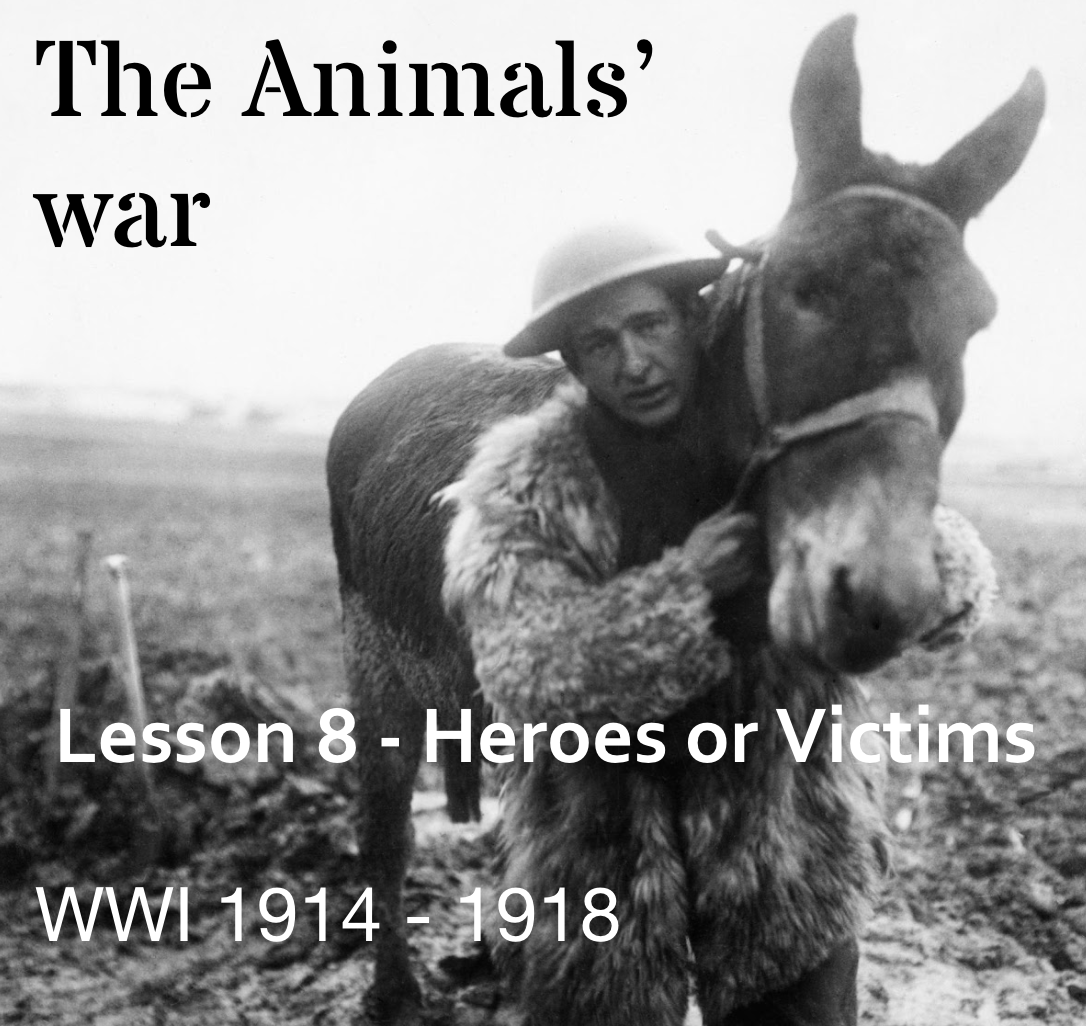
Learning Outcomes
• Know that people have different interpretations regarding the role of animals such as horses, dogs and pigeons used in WWI.
Success Criteria
• Understand how historical evidence is used to make contrasting arguments concerning the use of animals in WWI.
Sort the sources into ‘primary’ and ‘secondary’; ‘more reliable’ and ‘less reliable’; or any other grouping that helps them answer the question.
• Ask them to decide which evidence they would give most weight to, and which least?
Sort the sources into ‘primary’ and ‘secondary’; ‘more reliable’ and ‘less reliable’; or any other grouping that helps them answer the question.
• Ask them to decide which evidence they would give most weight to, and which least?
Do you think the clip portrayed the animals as heroes or victims.
Based on their knowledge of animals in WWI, how realistic do you think the film is?
- Is Joey the horse is represented as a hero or a victim, or both.
- Is the portrayal more realistic than the previous clip?
- Why do you think this?
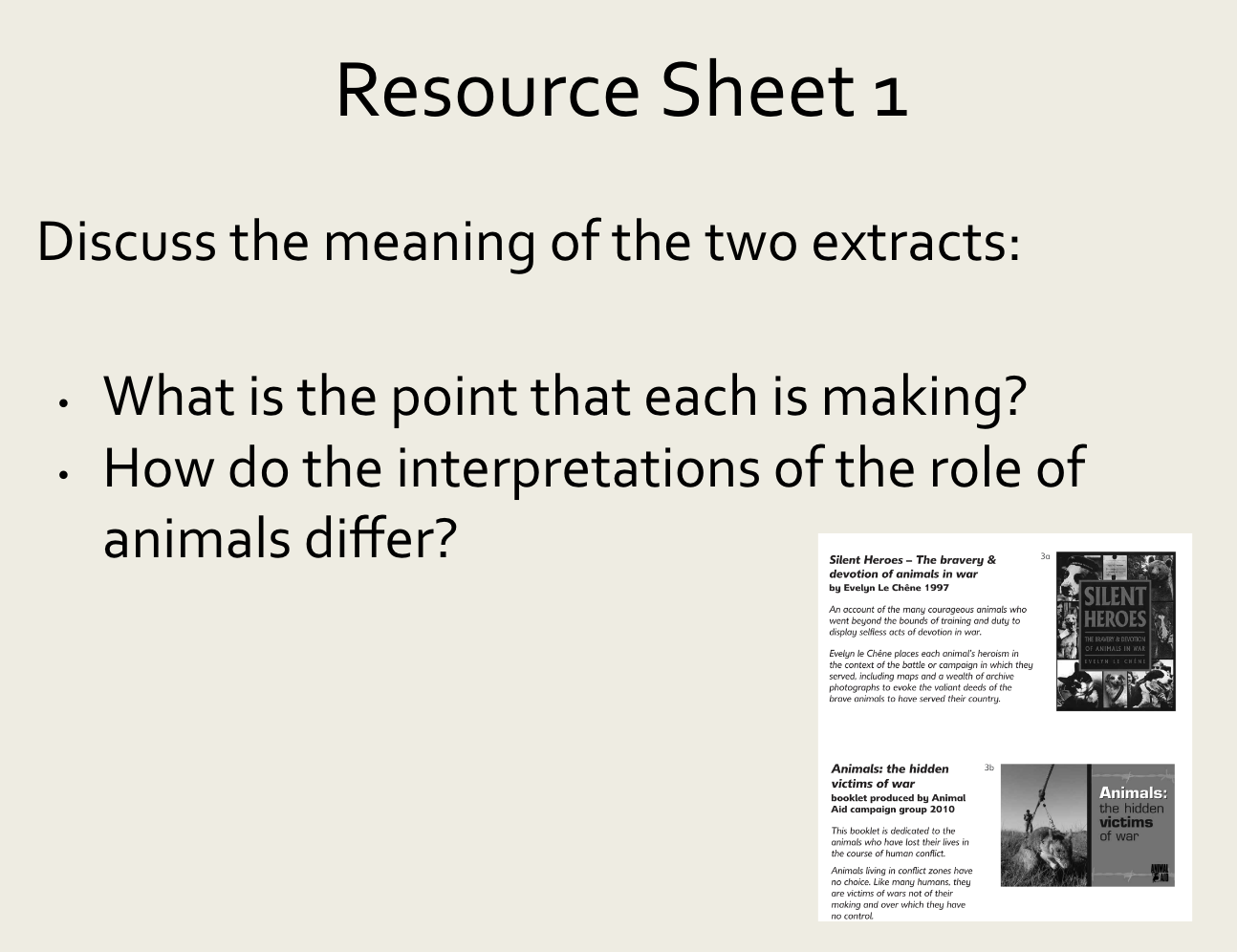
Do you think that the animals were heroes or victims?
• In Google Classroom are Resource sheets 2 - 6.
• Carefully study the sources and then to sort them into groups that will help you answer the question above.
When analysing the soources• Think about how to sort the sources into groups:
1) that support the case that animals were ‘victims’
2) that support that case that animals were ‘heroes’
3) that could be used to support either or both
Sort the sources into ‘primary’ and ‘secondary’; ‘more reliable’ and ‘less reliable’; or any other grouping that helps you answer the question.
• Decide which evidence you would give most weight to, and which least?
Which three pieces of evidence would you choose to answer the question? Why?
Write a TEXAS paragraph to explain.
-
EXPLORE / TŪHURA learning intentions:
- We are ANALYSING the impact of war on New Zealand society, focusing on the changing roles of women.
- We are RESEARCHING and IDENTIFYING the different contributions of NZ women during wartime.
- We are EVALUATING the significance of these contributions to the war effort.
- We are COMPARING and CONTRASTING the experiences of women on the home front and in active service.
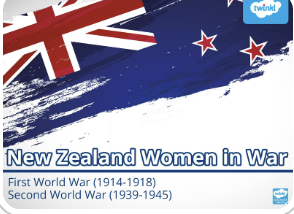
New Zealand Women in War
Learning Objectives
Students will analyze the impact of war on New Zealand society, focusing on the changing roles of women.
Students will research and identify the different contributions of NZ women during wartime.
Students will evaluate the significance of these contributions to the war effort.
Students will compare and contrast the experiences of women on the home front and in active service.
Students will develop research and critical thinking skills through inquiry-based learning.
Lesson 1: Introduction: Beyond the Trenches
Do Now: Brainstorm what students know about the role of women in war.
Introduction: Discuss the traditional focus on soldiers in wartime narratives.
Shifting the Focus: Introduce the concept of the "home front" and the vital contributions of women during wartime.
Source Analysis: Analyze primary and secondary sources (e.g., photos, diary entries, news articles) depicting the experiences of NZ women in WWI or WWII.
Questions to Consider: What jobs did women take on? How did the war impact their daily lives? What evidence suggests their contributions were significant?
Exit Ticket: Briefly write about one way the war might have changed the lives of women in New Zealand.
Lesson 2: Roles on the Home Front
Do Now: Briefly review the concept of the home front and its importance during wartime.
Research Groups: Divide students into groups and assign each group a specific role NZ women played on the home front during WWI or WWII (e.g., nurses, factory workers, farmers).
Group Research: Students research their assigned role using provided resources (books, websites, documentaries). They will focus on the responsibilities, challenges, and impact of these women's contributions.
Group Presentations: Each group presents their findings to the class, highlighting key points and using visuals if available.
Lesson 3: Beyond the Home Front
Do Now: Briefly review the different roles women played on the home front.
Expanding the Narrative: Discuss the lesser-known stories of NZ women who served overseas in various capacities (e.g., nurses, drivers, entertainers).
Case Studies: Present case studies of individual NZ women who served overseas during wartime. Students analyze primary sources (letters, diaries) to understand their experiences and motivations.
Class Discussion: Facilitate a class discussion about the challenges and contributions of these women. How did their experiences differ from those on the home front?
Lesson 4: Legacy and Significance
Do Now: Briefly review the different roles NZ women played during wartime.
Long-Term Impact: Discuss the long-term impact of the war on NZ society, particularly regarding women's rights and opportunities. How did the war contribute to social change?
Commemoration: Explore memorials and commemorative events that acknowledge the contributions of NZ women in war.
Creative Project: Students choose a creative format (e.g., poem, poster, short video) to represent the significance of NZ women's wartime contributions.
Gallery Walk: Students share their creative projects in a gallery walk format, allowing for peer feedback and appreciation.
-
EXPLORE / TŪHURA learning intentions:
- We are ANALYSING the impact of war on New Zealand society, focusing on the changing roles of women.
- We are RESEARCHING and IDENTIFYING the different contributions of NZ women during wartime.
- We are EVALUATING the significance of these contributions to the war effort.
- We are COMPARING and CONTRASTING the experiences of women on the home front and in active service.

New Zealand Women in War
Learning Objectives
Students will analyze the impact of war on New Zealand society, focusing on the changing roles of women.
Students will research and identify the different contributions of NZ women during wartime.
Students will evaluate the significance of these contributions to the war effort.
Students will compare and contrast the experiences of women on the home front and in active service.
Students will develop research and critical thinking skills through inquiry-based learning.
Lesson 1: Introduction: Beyond the Trenches
Do Now: Brainstorm what students know about the role of women in war.
Introduction: Discuss the traditional focus on soldiers in wartime narratives.
Shifting the Focus: Introduce the concept of the "home front" and the vital contributions of women during wartime.
Source Analysis: Analyze primary and secondary sources (e.g., photos, diary entries, news articles) depicting the experiences of NZ women in WWI or WWII.
Questions to Consider: What jobs did women take on? How did the war impact their daily lives? What evidence suggests their contributions were significant?
Exit Ticket: Briefly write about one way the war might have changed the lives of women in New Zealand.
Lesson 2: Roles on the Home Front
Do Now: Briefly review the concept of the home front and its importance during wartime.
Research Groups: Divide students into groups and assign each group a specific role NZ women played on the home front during WWI or WWII (e.g., nurses, factory workers, farmers).
Group Research: Students research their assigned role using provided resources (books, websites, documentaries). They will focus on the responsibilities, challenges, and impact of these women's contributions.
Group Presentations: Each group presents their findings to the class, highlighting key points and using visuals if available.
Lesson 3: Beyond the Home Front
Do Now: Briefly review the different roles women played on the home front.
Expanding the Narrative: Discuss the lesser-known stories of NZ women who served overseas in various capacities (e.g., nurses, drivers, entertainers).
Case Studies: Present case studies of individual NZ women who served overseas during wartime. Students analyze primary sources (letters, diaries) to understand their experiences and motivations.
Class Discussion: Facilitate a class discussion about the challenges and contributions of these women. How did their experiences differ from those on the home front?
Lesson 4: Legacy and Significance
Do Now: Briefly review the different roles NZ women played during wartime.
Long-Term Impact: Discuss the long-term impact of the war on NZ society, particularly regarding women's rights and opportunities. How did the war contribute to social change?
Commemoration: Explore memorials and commemorative events that acknowledge the contributions of NZ women in war.
Creative Project: Students choose a creative format (e.g., poem, poster, short video) to represent the significance of NZ women's wartime contributions.
Gallery Walk: Students share their creative projects in a gallery walk format, allowing for peer feedback and appreciation.
-
Kotahitanga and The Olympics
Past, Present and Future - How we come together through competition
Achievement Objectives
Ngā mahinga ohaoha | Economic activity
This context focuses on how people seek to meet their needs and wants and the constraints some face in doing so; how people make a living individually and collectively and the exchanges and interconnections that result from this; and people’s rights and responsibilities as producers, workers, and consumers. It considers different ways in which economies allocate scarce resources and the resulting national and global consequences for equity and for people’s wellbeing.
KNOW: Within Aotearoa New Zealand’s histories, iwi and hapū experimented with new economic opportunities to enhance their mana. In doing so, they built extensive trading networks domestically and with Australia.Students will be able to identify ways in which the Olympic Games promote a sense of unity among participating nations.
FOCUS / ARONGA learning intentions:
- We are FOCUSING on identifying the key features of a united world and how the Olympic Games contribute to this concept
Students can explain how the Olympic Games promote some of these characteristics (e.g., athletes from different countries competing together, truce during the Games).EXPLORE / TŪHURA learning intentions:
- We are EXPLORING to analyse the connections between the Olympic Games and the concept of a united world.
- Students can develop a proposal or campaign idea related to the Olympics that fosters unity (e.g., designing a poster promoting cultural exchange between athletes, creating a class presentation on sportsmanship).
- Students can plan the steps involved in their chosen project and identify resources needed.
PLAN & DO / WHAKAMAHI learning intentions:
- We are PLANNING to create a plan so that we can promote a united world through the Olympic Games.
Students can develop a proposal or campaign idea related to the Olympics that fosters unity (e.g., designing a poster promoting cultural exchange between athletes, creating a class presentation on sportsmanship).
Students can plan the steps involved in their chosen project and identify resources needed.
Enter text here...
REFLECT / WHAIWHAKAARO learning intentions:
- We are REFLECTING on our learning to evaluate the effectiveness of the Olympic Games in promoting a united world.
Students can discuss the strengths and limitations of the Olympic Games in fostering unity.
- Students can form an opinion on the effectiveness of the Games in creating a more peaceful and cooperative world, supported by evidence from their learning.
-
Enter text here...
FOCUS / ARONGA learning intentions:
- We are FOCUSING on identifying the key features of a united world and how the Olympic Games contribute to this concept
- We are FOCUSING on understanding the significance of the opening ceremony and the uniqueness of this.
- We are FOCUSING on understanding how mascots can represent a culture
Enter text here...
Getting to know France
- Students are to complete Activity 01A; Find someone who knows. This will get students thinking about France and Paris.
- Watching the video about France and Paris. https://www.youtube.com/watch?v=mu7T6y-tvMs
- Discussion on the ways in which Aotearoa New Zealand and France are vastly different.
- Are there any similarities? What differences are there?
- Complete this activity on getting to know France.
- https://app.wizer.me/learn/C7YPFI
Cultural Practices- Compare some cultural practices between Aotearoa New Zealand and France.
- Read Resource 01B; Culture, holidays, celebrations and family.
- Working with a partner, ask students to produce a similar summary of cultural practices in Aotearoa New Zealand, using their experiences and whānau as an example.
- The summary should also show why it is important to keep culture alive by maintaining traditions.
- Students are to show their learning as an infographic or a poster. They could use Canva to produce the final artwork.
Paris as a tourist destination
- Watch the Paris Vacation Travel Guide as a class. This travel guide is just over six minutes and is a good introduction to many of Paris’s famous tourist attractions.
- https://www.youtube.com/watch?v=AQ6GmpMu5L8
- This is an overview of the city and covers history, geography, lifestyle and technology.
ACTIVITY
- Students are to choose ONE of the tourist destinations from Paris that was mentioned in the video link.
- Students are to imagine they are visiting Paris and writing a blog or a letter about their visit to this destination.
-
Enter text here...
FOCUS / ARONGA learning intentions:
- We are FOCUSING on identifying the key features of a united world and how the Olympic Games contribute to this concept
- We are FOCUSING on understanding the significance of the opening ceremony and the uniqueness of this.
- We are FOCUSING on understanding how mascots can represent a culture
Paris – an Olympic city
The Paris 2024 Olympic and Paralympic Games will be the biggest event ever organised in France, taking place from 26 July to 11 August. The Olympic Games are a popular multi-cultural festival of sport, culture and fun. It will be a celebration that France will share with the rest of the world.
The Mega City
This section looks at the population of the city and how it has grown over time. Students will investigate the population of Paris, how the city has grown and what makes it a mega city.
An extension activity includes an examination of thecpositives and negatives of mega cities.
ACTIVITY
Complete Resource 02A; Paris – A mega city.
Climate
This section looks at the climate of Paris. Students will explore the climate graph of Paris and will investigate the recent extreme weather events in Paris, suggesting solutions to coping with extreme weather events.
ACTIVITY
Complete Resource 02B; The climate of Paris.
Plan a trip
ACTIVITY
Ask students to imagine they are going to the Olympic Games to watch someone from their whānau compete in a sport of their choosing.
Students are to plan a trip to Paris for themselves and one adult. They will need to prepare a travel itinerary for two weeks – including costs and supporting details for their two-person party.
Students will need to show the following:
How they will be travelling around France and Paris – trying to be sustainable.
- Where they will stay. They may need to stay in a range of different places, so encourage students to consider a variety of options and prices.
- How their group will travel to France and Paris.
- Travel while they are in Paris.
- The costs of entry to the sporting event.
- Visits to at least THREE Paris tourist icons
- Spending money, converted into New Zealand dollars.
-
Enter text here...
EXPLORE / TŪHURA learning intentions:
- We are EXPLORING to analyse the connections between the Olympic Games and the concept of a united world.
The Opening Ceremony
The opening ceremony is normally one that is unique and original. Host nations try to ensure that the ceremony represents their country, as well as making it really unique.
Watch the short clips below of opening ceremonies.
One of the highlights of the 2008 Beijing Olympics was the moment when 2,008 drummers played the bronze Fou drums and sang the quote from The Analects of Confucius, written 2000 years ago.
https://www.youtube.com/watch?v=TA0ZVxHRxCM
At the 2012 London Olympics, the late Queen Elizabeth II, appeared with James Bond as 007. She helicoptered into the stadium, flying past lots of London’s famous landmarks such as The London Eye, the Tower of London and the London Gherkin.
https://www.youtube.com/watch?v=1AS-dCdYZbo
At the 2020 Tokyo Olympics, hundreds of light
- equipped drones flying around the sky in formation
- creating shapes, objects and words – created a spectacle at the opening ceremony as artists sang John Lennon’s ‘Imagine’.
https://www.youtube.com/watch?v=UJyReGFKQU8
ACTIVITY
Using this link and Google Maps, students are to explore the route of the opening ceremony.
https://www.paris2024.org/en/ceremony/
Visit some of the special places that athletes will see as they sail along the River Seine.
Ask students to calculate the distance the route will cover using the measuring tool on Google Maps.
The importance of a mascot
Discuss as a class what a mascot is and what purposes a mascot might have.
Follow-up by watching this video on the background and history of Olympic mascots (this covers up to the Rio games).
https://www.youtube.com/watch?v=tJCrUSg-B_Y
ACTIVITY
Students can explore the official Paris Olympic Games mascot website, watching the mascot clips individually or as a class.
https://olympics.com/en/olympic-games/paris-2024/mascot
Students can then create their own mascot for the Aotearoa New Zealand athletes.
The mascot they create should be focused on representing the past and the future of Aotearoa New Zealand culture. Students need to annotate their mascot design to explain how it represents the past/history while also looking towards the future.
-
Enter text here...
EXPLORE / TŪHURA learning intentions:
- We are EXPLORING to analyse the connections between the Olympic Games and the concept of a united world.
- We are explaining/identifying basic terms related to world population (e.g., population density, birth rate, death rate).
- We are EXPLORING to predict future population trends based on current data.
History of the Olympic Games
How did the Olympics become the greatest show of sporting excellence on earth?
Thousands of years in the making, the Olympics began as part of a religious festival honouring the Greek god Zeus in the rural Greek town of Olympia. But how did it become the greatest show of sporting excellence on earth? Armand D’Angour explains the
evolution of the Olympics.
Together as a class watch this video.
https://www.youtube.com/watch?v=hNJrwT8vqAk
Discussions
- · Does this apply today?
- · Do we have similar sayings?
How is this Olympic Creed similar or different to the whakatauki below:
“Whāia te iti kahurangi, ki te tuohu koe, me he maunga teitei.”
Seek ye the treasures of your heart and if you bow, then let it be to a lofty mountain. Aim high for what is truly valuable and be persistent. Don’t let obstacles stop you from reaching your goal.
https://www.youtube.com/watch?v=FvVLZpG_xgE
New sports
There are 32 different sporting codes at the 2024 Paris Olympics.
One sport is new – Breaking – and three return from their first time in Tokyo – Sport climbing, Skateboarding and Surfing.
ACTIVITY
Find out more about each of these sporting codes.
Breaking
https://www.paris2024.org/en/sport/breaking/
Suggest two reasons as to why they think this sport has been added for these Olympics.
Sport Climbing
https://www.paris2024.org/en/sport/sport-climbing/
Explain what it is about Sport Climbing that makes it an exciting sport to watch and enjoy, and what some of the rules are.
Skateboarding
https://www.paris2024.org/en/sport/skateboarding/
Explain how the skateboarding competitions will be judged. Then, ask students to imagine they are representing New Zealand at this event; what would be the most complicated trick they could do?
Surfing
https://www.paris2024.org/en/sport/surfing/
Name where this event will be held for the Paris 2024 Games, then suggest three reasons why this particular location was selected.
Then:
Get students to write a persuasive letter to the IOC to ask them to add a new sport to the next Olympics.
Sports represented at the Paris Olympics
There will be 32 sports represented at the Olympic Games in Paris in 2024. Only one new sport has been included.
Most of the events will be held in Paris or nearby but events such as Football and Basketball will be held across the nation. Surfing will be held in Tahiti.
Complete Activity 03A; Sports represented at the Paris Olympics.
-
Enter text here...
EXPLORE / TŪHURA learning intentions:
- We are EXPLORING to analyse the connections between the Olympic Games and the concept of a united world.
Berlin 1936: The Backstory
The bidding for these Olympic Games was the first to be contested by IOC members casting their votes for their favourite host city.
There were many other cities around the world that wanted to host this Summer Olympics, but they did not receive any IOC votes.
The other cities competing to hold the games were: Alexandria, Barcelona, Buenos Aires, Cologne, Dublin, Frankfurt, Helsinki, Lausanne, Nuremberg, Rio de Janeiro, and Rome.Berlin won the bid to host the Games over Barcelona, Spain, on 26 April 1931, at the 29th IOC Session in Barcelona.
The vote occurred in 1931 during the Weimar Republic era, before Adolf Hitler rose to power in 1933.
When Berlin was chosen as the host city for these Olympics few imagined that within such a short period of time they would be imbued with so much political significance given to them by the emergence of Hitler and the Nazi Party.
To outdo the Los Angeles, USA games of 1932, the Nazis built a new 100,000-seat track and field stadium, six gymnasiums, and many other smaller arenas.In many ways it was the first modern Olympics.
It was the first to be televised
It was the first to have a torch relay
It was the first to use the Olympics rings as a symbol extensively
Many of the traditions of the modern ‘Olympic’ Games originated with the 1936 Berlin Olympics.
The Logo of the Berlin Olympics was the ‘Olympia Glocke’ – the Olympic Bell – to be tolled at the opening and closing of the Games.
One of the ‘secrets’ of the London 2012 Games, revealed at the opening ceremony, was a huge bell tolled as the games were opened.
The Original ‘Olympia Glocke’ survived the 1939-1945 war, and still exists, and can be seen outside the Berlin ‘Olympic Stadium’.
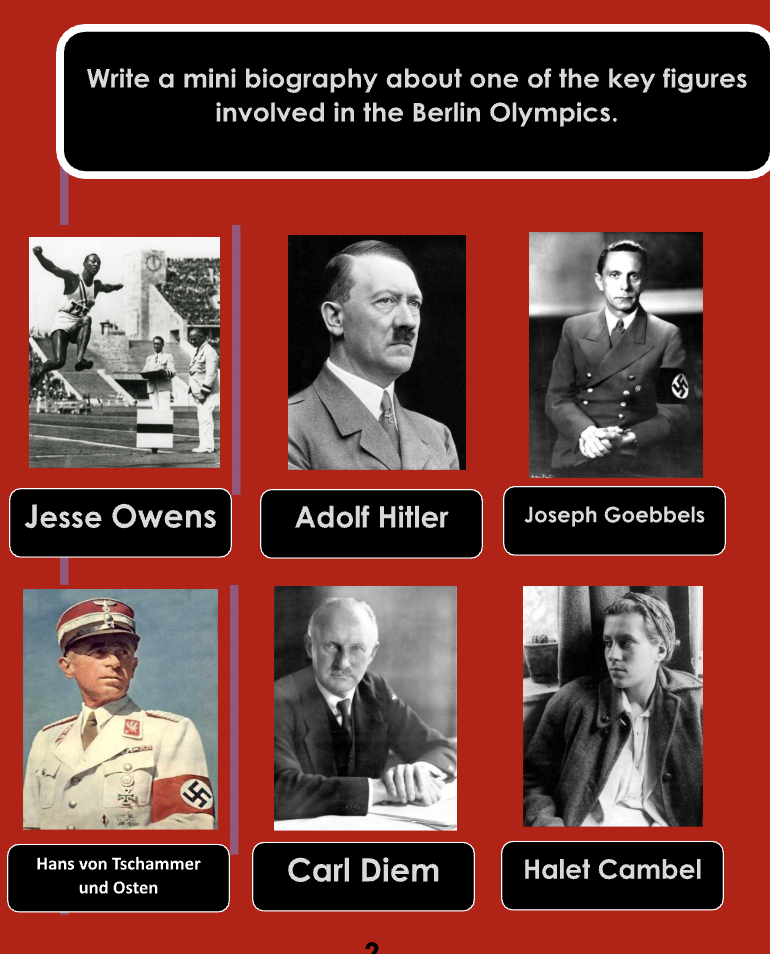
-
Enter text here...
PLAN & DO / WHAKAMAHI learning intentions:
- We are PLANNING to read through primary and secondary sources so that we can understand how the 1936 Berlin Olympics began to create a future for the Olympic movement.
Using the information below, we are looking at different sources to find evidence for our questions.
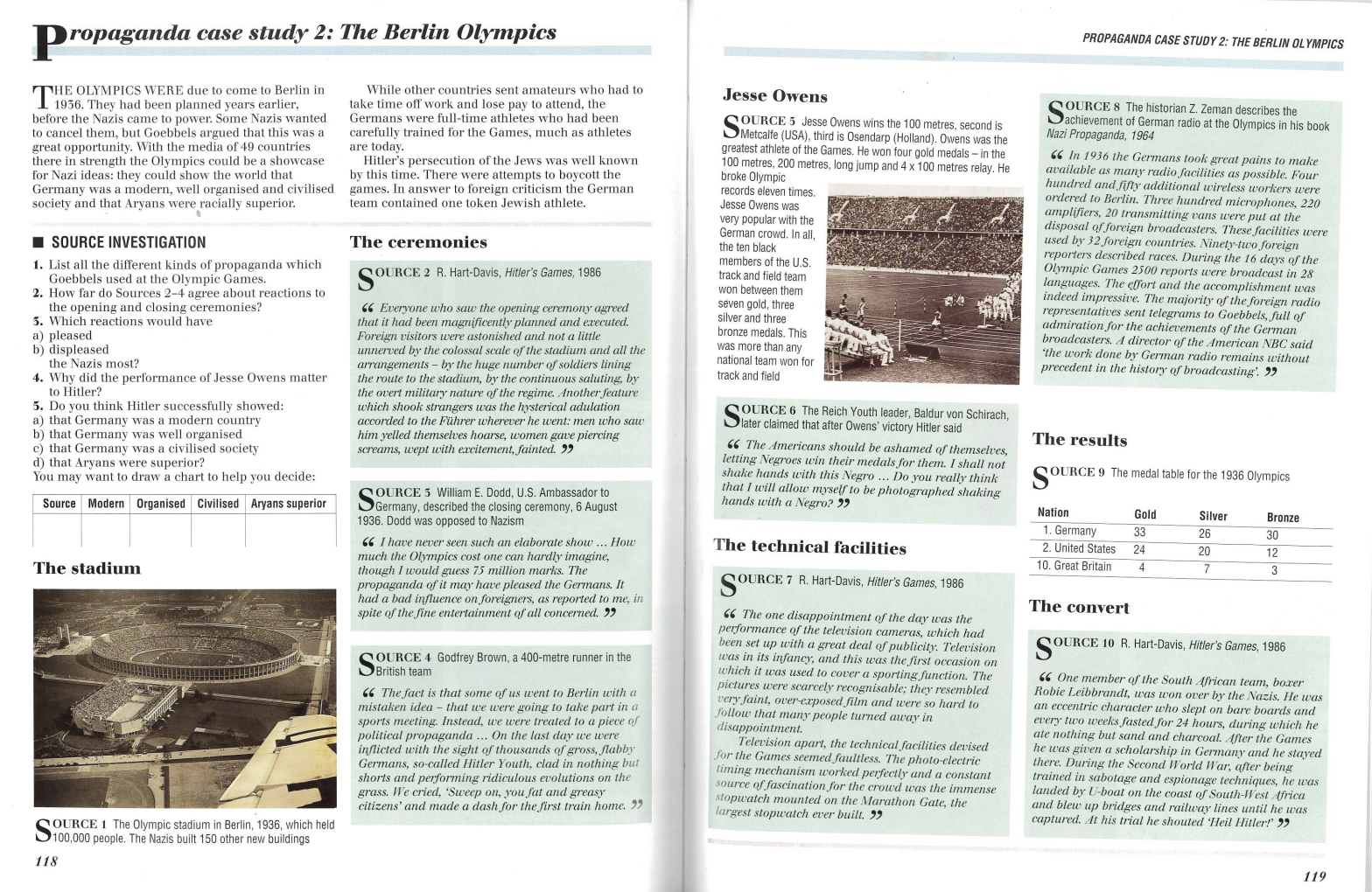
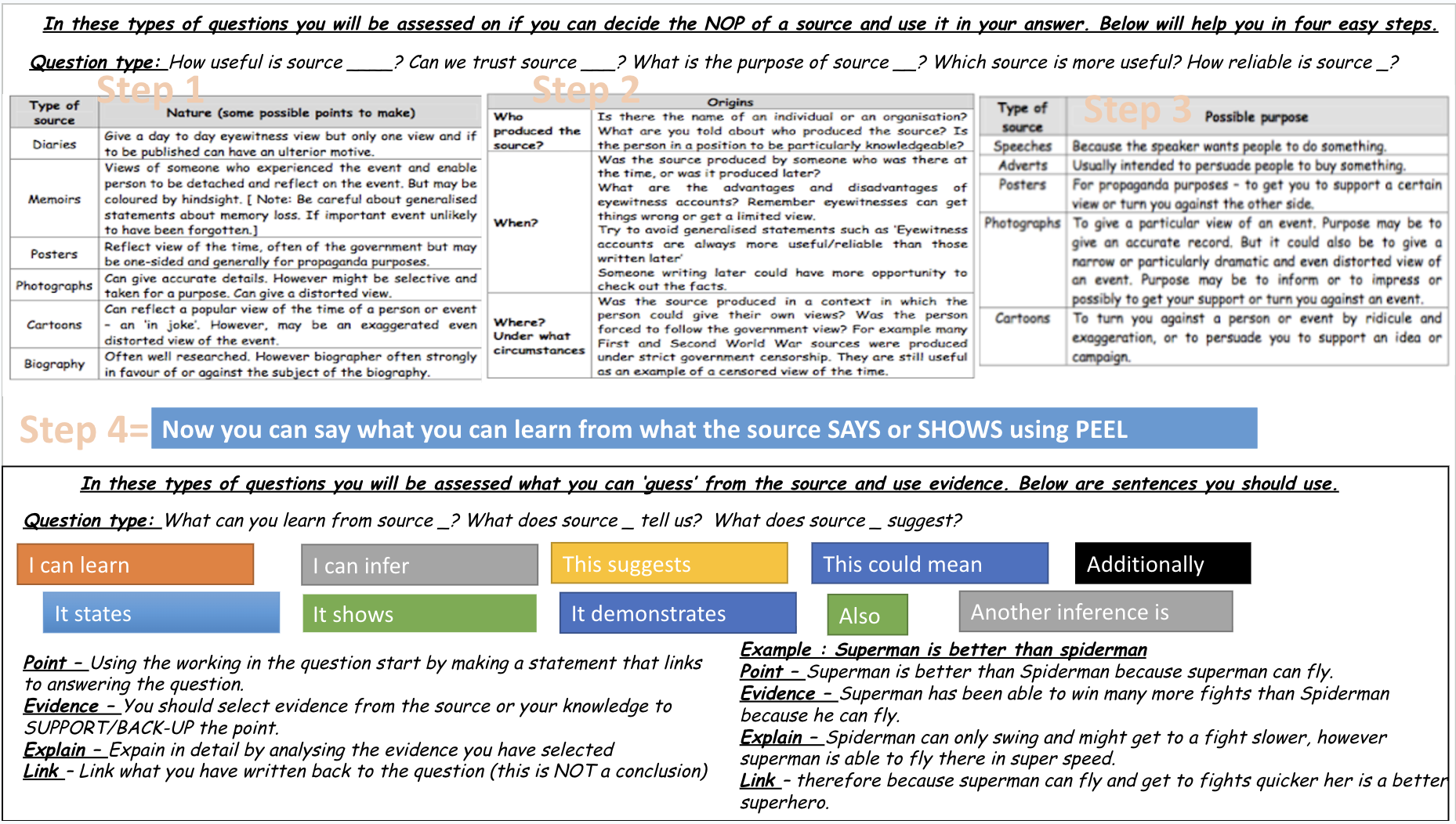
-
Enter text here...
PLAN & DO / WHAKAMAHI learning intentions:
- We are PLANNING to create a plan so that we can promote a united world through the Olympic Games.
- We are PLANNING to read through primary and secondary sources so that we can understand how the 1936 Berlin Olympics began to create a future for the Olympic movement.
We are working on our assessment to analyse static images and produce an image reinforce the Nazi control over the Olympics and the devleopment of race relations through this time.
Assessment week.
-
Enter text here...
PLAN & DO / WHAKAMAHI learning intentions:
- We are PLANNING to create a plan so that we can promote a united world through the Olympic Games.
- We are PLANNING to read through primary and secondary sources so that we can understand how the 1936 Berlin Olympics began to create a future for the Olympic movement.
We are working on our assessment to analyse static images and produce an image reinforce the Nazi control over the Olympics and the devleopment of race relations through this time.
Assessment week.
-
Enter text here...
FOCUS / ARONGA learning intentions:
- We are FOCUSING how the world has developed through the devleopment of the Olympics and China's One Child Policy
- We are FOCUSING...
- We are FOCUSING...
Enter text here...
Main:
Explain that we are here to find out what the one child policy is, why it was introduced and what impacts it has had in China
Task 1: Quick on the draw. (Literacy)
Read the statement of factual information regarding the one child policy. Pupils are to then answer as many questions in the given time.
Task 2: Impacts of the policy (Evaluation and explanation)
Pupils to read the cards on the various impacts the one child policy has had and divide them into positive and negative outcomes. Using this information pupils write a short balanced answer, answering the question. ‘The one child policy has only had negative effects. Do you agree?’ Discuss use of developing explanation for level 6 attainment
Task 3: Case studies (Empathy and decision making)
Pupils are to read two case studies of people in China and evaluate the impacts of the one child policy on different people. Discuss use of explanation, balance and examples for level 6 attainment.
Task 4: Statistics (Numeracy)
Pupils are to complete and interpret the statistical data and graph, analysing the predicated future population of China.
Session 2Watch the videos:
1. China's one-child policy explained - BBC News
2. Inside China’s One-Child Policy: Unexpected Consequences
During Reading
Read the article “China easing birth limits further to cope with aging society” from CBC News.
After Reading
Answer the article comprehension questions.
Complete 1 of the 2 journal topics:
1. What are the possible consequences of a country not having enough people to support their workforce? Explain.
2. Why is it important for a government to monitor census data and other statistics and graphs (e.g., population pyramids) about the country it runs? Why is understanding data important? How do you think the government uses data to make decisions?
-
EXPLORE / TŪHURA learning intentions:
- We are EXPLORING to understand the concept of cultural identity and diversity.
- We are EXPLORING...
- We are EXPLORING...
As I am away from Thursday 18th until Tuesday 22nd, here is your work for the two sessions, we should be having over the 4 days. You may work on it at home as well. However, presentations of your Halloween Celebration activity will happen from Wednesday 23rd.
1. Complete Halloween Webquest below (this should be complete on Friday 18th October, if not complete for homework)
2. Halloween Celebrations around the world brochure/pamphlet activity.
3. Halloween Crossword (collect from teacher and glue into book)
2. Halloween Celebrations around the World activity.
Each country celebrate their dead and spirits in different ways. Today, you’re going to explore some of these. Each of you have been allocated one of these (no overlap) and share what you’ve learned with the class and you will work and present individually on this task.
You will create a 3 fold brochure or A3 poster online to represent your celebration. Use an online program of your choice - google slides, google doc, canva etc.
Goal- compare and contrast celebrations of the dead and spirits from around the world
- cross cultural skills
- speaking/listening
- Seemingly different cultures are not really that different
- Awareness of these different holidays
- Improved presentation and research skills
- Improved advisory and culture
- Improved listening and attention skills.
Questions to be answered:- Where does this take place?
- What time of year?
- How is it celebrated?
- Special dress?
- Special activities?
- Special food?
- Special locations?
- Special music?
Make sure you add your presentation to the assignment -
EXPLORE / TŪHURA learning intentions:
- We are EXPLORING to understand the concept of cultural identity and diversity.
- We are EXPLORING...
- We are EXPLORING...
As I am away from Thursday 18th until Tuesday 22nd, here is your work for the two sessions, we should be having over the 4 days. You may work on it at home as well. However, presentations of your Halloween Celebration activity will happen from Wednesday 23rd.
1. Complete Halloween Webquest below (this should be complete on Friday 18th October, if not complete for homework)
2. Halloween Celebrations around the world brochure/pamphlet activity.
3. Halloween Crossword (collect from teacher and glue into book)
2. Halloween Celebrations around the World activity.
Each country celebrate their dead and spirits in different ways. Today, you’re going to explore some of these. Each of you have been allocated one of these (no overlap) and share what you’ve learned with the class and you will work and present individually on this task.
You will create a 3 fold brochure or A3 poster online to represent your celebration. Use an online program of your choice - google slides, google doc, canva etc.
Goal- compare and contrast celebrations of the dead and spirits from around the world
- cross cultural skills
- speaking/listening
- Seemingly different cultures are not really that different
- Awareness of these different holidays
- Improved presentation and research skills
- Improved advisory and culture
- Improved listening and attention skills.
Questions to be answered:- Where does this take place?
- What time of year?
- How is it celebrated?
- Special dress?
- Special activities?
- Special food?
- Special locations?
- Special music?
Make sure you add your presentation to the assignment -
Enter text here...
FOCUS / ARONGA learning intentions:
- We are FOCUSING on understanding the key concepts and skills associated with map reading, graph interpretation, and political cartoon analysis
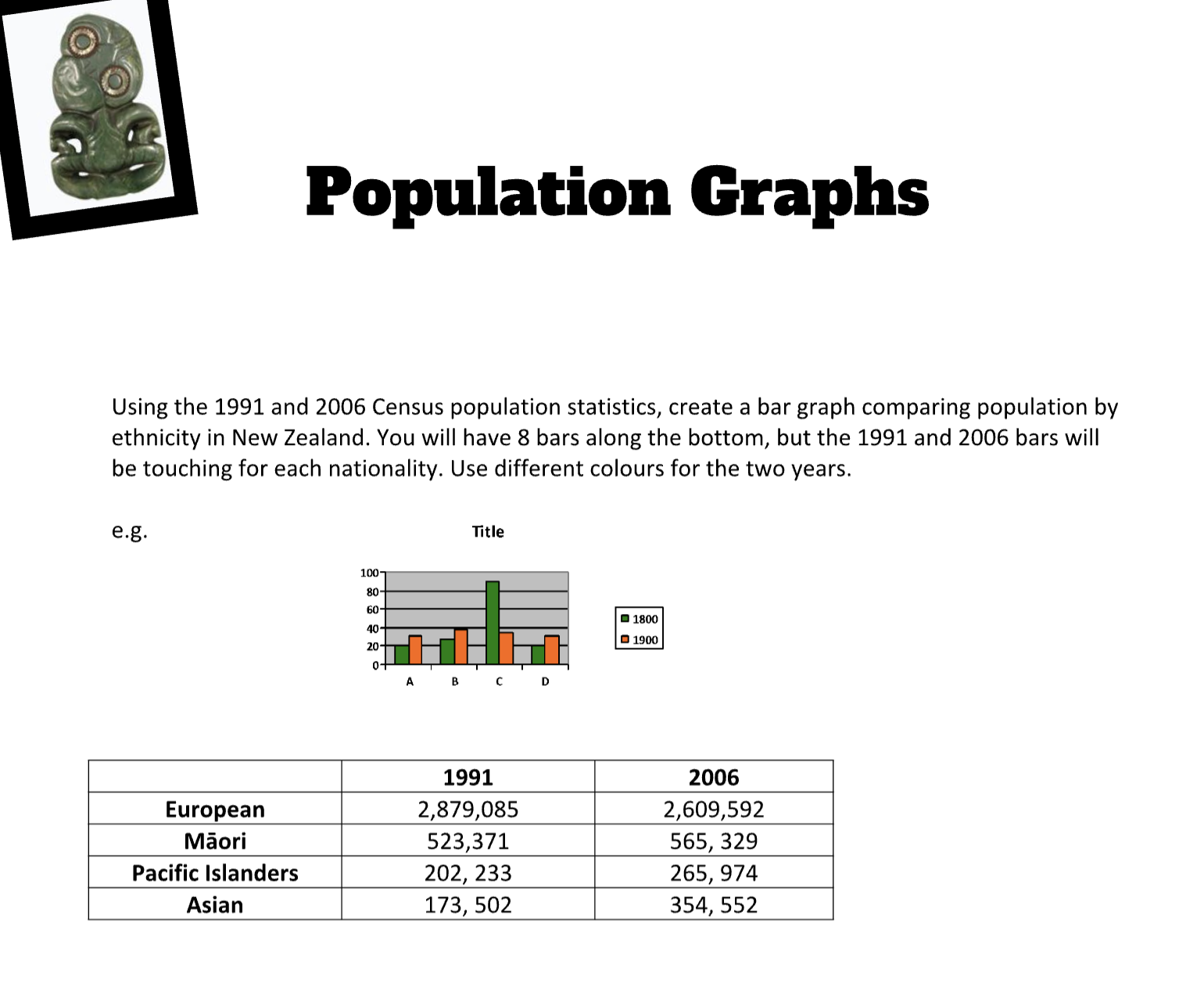
Complete the activities in Google Classroom in your book.
-
FOCUS / ARONGA learning intentions:
- We are FOCUSING on understanding the key concepts and skills associated with map reading, graph interpretation, and political cartoon analysis
This week we are focussing on understanding maps and how they are used in the world today.
Work through the infomation in Google Classroom and make sure you understand the geography skills included.
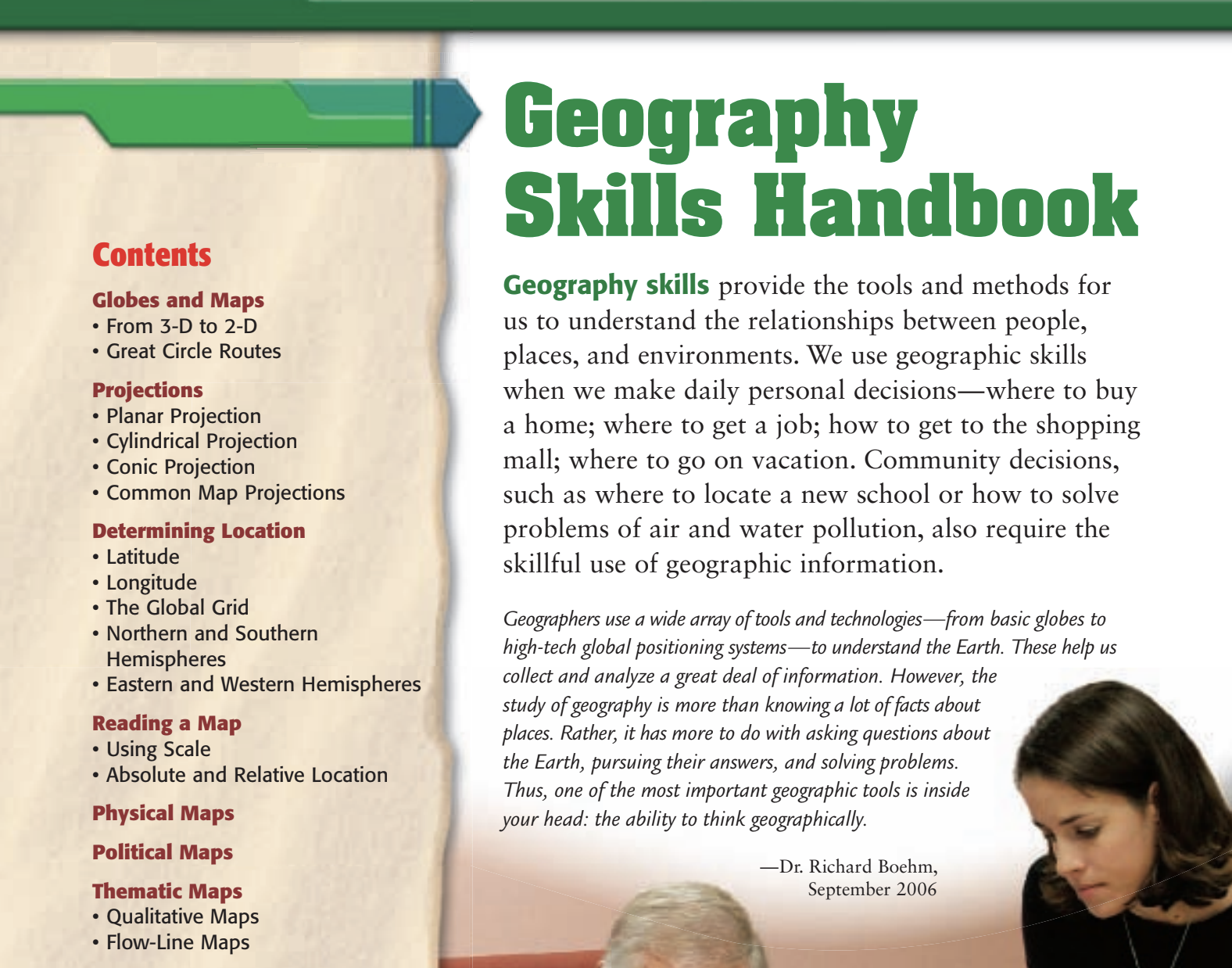
-
Enter text here...
FOCUS / ARONGA learning intentions:
- We are FOCUSING on developing our map reading skills so we can think like a geographer
- We are FOCUSING...
- We are FOCUSING...
Enter text here...
Map and Globe Skills Review
Cardinal and Intermediate Directions
Terms you will need to know: compass rose, cardinal directions, intermediate directions. Skill you will need to have: how to determine cardinal and intermediate directions from and to a given location.
Label the blank compass rose with S, E, W (these are called cardinal directions, along with N), then add NW, SW, NE, SE (these are called intermediate directions).
Map Data
Terms you will need to know: map data, points, lines and areas.
Map data consists of POINTS, LINES and AREAS. On the map below, the location of Stillwater Junior High School is indicated with a POINT (in the shape of a star).
1. Provide an example of a location on the map below that is indicated with a LINE:
2. Provide an example of a location on the map below that is indicated with an AREA:
1
Parts of a Map
Terms you will need to know: TODALSS. Skills you will need to have: how to read a map legend and map scale, how to include accurate TODALSS elements on maps that you create.
Go to: http://tinyurl.com/8yr9v2c
Use the article to answer the questions below:
1. A “good” map includes seven TODALSS elements. What do T, O, L and S stand for?
T =
O =
D = Date (date that the map was made)
A = Author (name of the map’s cartographer)
L=
S=
S = Source (where the data that the map is based on is from)
Click on the link to scale in the article.
2. What does the scale of a map indicate?
3. Which kind of map shows more detail, smallscale or largescale?
2
Continents and Oceans (Use an atlas if needed)
Terms you will need to know: continent, ocean, hemisphere. Locations you will need to know: Africa, Antarctica, Asia, Australia, Europe, North America, South America, Arctic Ocean, Atlantic Ocean, Indian Ocean, Pacific Ocean, Southern Ocean, Northern, Southern, Western and Eastern hemispheres.
Label the 7 continents and 5 oceans on the map below. Draw a SOLID LINE to separate the Northern and Southern hemispheres. Draw a DOTTED LINE to separate the Western and Eastern hemispheres.
3 Latitude and Longitude
Terms you will need to know: hemisphere, Equator, parallels, meridians, Prime Meridian, International Date Line, latitude, longitude. Skill you will need to have: how to determine absolute location using latitude and longitude coordinates.
Go to: http://tinyurl.com/yjx43kz
Scroll down the page until you see the black box below. Use the tutorial to help you answer the questions below. You’ll need to click the green arrow in the lower right hand corner (requires FLASH).
1. A hemisphere is:
2. The Equator is:
3. Meridians are:
4. The Prime Meridian is:
5. A line of latitude (also called a parallel) is:
6. A line of longitude (also called a meridian) is:
7. How many total degrees of longitude are there?
8. How many degrees of latitude are there between the Equator and the North Pole?
The Equator and the South Pole?
Prime Meridian
Go to: http://tinyurl.com/39nanx
4 Use the article to help you answer the questions below.
1. What is the International Date Line?
2. When and how was the Greenwich Meridian selected as the official Prime Meridian?
3. Identify the latitude and longitude of each location on the map:
Location
Latitude (N or S)
Longitude (E or W)
A
B
C
D
E
F
G
5 Map Projections
Term you will need to know: map projection. Understanding you will need to have: why geographers use different map projections rather than one map projection.
View this video, “Map Projections”, to gain a better perspective on what map projections are: http://tinyurl.com/odgcoog
1. What is a map projection?
2. Why do you think geographers use different map projections rather than just one?
Time Zones
Terms you will need to know: time zones, contiguous. Understanding you will need to have: why we use time zones instead of uniform times around the world. Skills you will need to have: how to read a time zone map and calculate time differences between locations.
.
Go to: http://tinyurl.com/de2ezc
Under “Toys” on the left side of the window, click on world sunlight. Underneath the earth image, click on the various map projections to explore how they change the image (Mercator, Peters, Mollweide, equirectangular, etc.)
1. How does the World Sunlight Map help us understand the need for time zones?
Go to: http://tinyurl.com/7bt8mod
Use the article to help you answer the questions below.
1. How did the development of the railroad spur the adoption of time zones?
2. Time zone facts:
a. Total # of world time zones:
b. Distance apart:
c. When world time zones were officially established and where:
d. # of time zones in China and # of time zones China would have if it conformed:
e. Meaning of acronym UTC:
f. # of time zones in contiguous U.S.:
g. # of time zones in U.S., including AK, HI and overseas territories:
6
Go to: http://www.freelargeimages.com/wpcontent/uploads/2014/11/Time_zone_map9.gif Use the World Time Zone map to help you answer the questions below:
1. If it is noon in Dallas, TX, USA, what time is it in Lisbon, Portugal?
2. If it is noon in Manila, Philippines, what time is it in Casablanca, Morocco?
3. If it is noon in Oslo, Norway, what time is it in Karachi, Pakistan?
4. If it is noon in Singapore, what time is it in Santiago, Chile?
Label the contiguous U.S. time zones with their names (write on the dark lines on the map).
7
-
CAT Week
Study well
Revise hard
Keep well
Sleep well
Do well
-
Earthquake/Volcano Google Slides Project
Earthquake or Volcano Name: _____________________________________________
Keep this paper with you the whole time you are working on the google slides. Turn it into your teacher on the day of presentations.
Use your book and research the information. All information must be in your own words.
Make a 5-10 question worksheet to give to the listeners during your presentation. Have an answer key made for the worksheet and grade them after the presentation.
Earthquake
Location - Describe where and when the earthquake took place, use a map.
Plate motion - What tectonic plate motion caused the earthquake. Name the plates and describe the motion (direction of each plate). Boundaries - What type of plate boundary is at that location.
Epicenter - Give the exact epicenter, show a picture if possible. Define epicenter and describe how the epicenter is found.
Fault - What type of fault (strike-slip, normal, reverse) explains how that fault moves.
Waves - What type of waves: primary, secondary, or surface, did the earthquake have? Describe what that type of wave does, how it moves.
Magnitude - What was the earthquake's magnitude. Use the Modified Mercalli Scale and the Richter scale. Explain what each scale represents as well as the number associated with your earthquake.
Risk - What is the risk of another earthquake in that area? Explain how that is determined.
Extra Info - Extra interesting facts.
Volcano
Location - Where is the volcano located and when did it erupt, use a map.
Formation - How did the volcano form, (convergent boundary, divergent boundary, or hotspot)? Describe the formation. What tectonic movement caused the formation of the volcano.
Type of Volcano - Shield, composite, cinder cone, or Caldera. Describe the type of volcano.
Eruption style - Quiet or Violent, describe why it had this type of eruption.
Effects of Volcanic Eruption - Describe lava flow, ash fall, mudflow, or pyroclastic flow. What type of damage was done with the effects of the lava flow?
Prediction of next eruption - When is the next eruption predicted for, how do seismologists make this prediction?
Classification - What is the current classification of the volcano now (dormant, active, extinct). Describe what that classification means.
Eruptions and Climate Change - describe how volcanic eruptions contribute to climate change.
Extra Info - Extra interesting facts.
-
Earthquake/Volcano Google Slides Project
Earthquake or Volcano Name: _____________________________________________
Keep this paper with you the whole time you are working on the google slides. Turn it into your teacher on the day of presentations.
Use your book and research the information. All information must be in your own words.
Make a 5-10 question worksheet to give to the listeners during your presentation. Have an answer key made for the worksheet and grade them after the presentation.
Earthquake
Location - Describe where and when the earthquake took place, use a map.
Plate motion - What tectonic plate motion caused the earthquake. Name the plates and describe the motion (direction of each plate). Boundaries - What type of plate boundary is at that location.
Epicenter - Give the exact epicenter, show a picture if possible. Define epicenter and describe how the epicenter is found.
Fault - What type of fault (strike-slip, normal, reverse) explains how that fault moves.
Waves - What type of waves: primary, secondary, or surface, did the earthquake have? Describe what that type of wave does, how it moves.
Magnitude - What was the earthquake's magnitude. Use the Modified Mercalli Scale and the Richter scale. Explain what each scale represents as well as the number associated with your earthquake.
Risk - What is the risk of another earthquake in that area? Explain how that is determined.
Extra Info - Extra interesting facts.
Volcano
Location - Where is the volcano located and when did it erupt, use a map.
Formation - How did the volcano form, (convergent boundary, divergent boundary, or hotspot)? Describe the formation. What tectonic movement caused the formation of the volcano.
Type of Volcano - Shield, composite, cinder cone, or Caldera. Describe the type of volcano.
Eruption style - Quiet or Violent, describe why it had this type of eruption.
Effects of Volcanic Eruption - Describe lava flow, ash fall, mudflow, or pyroclastic flow. What type of damage was done with the effects of the lava flow?
Prediction of next eruption - When is the next eruption predicted for, how do seismologists make this prediction?
Classification - What is the current classification of the volcano now (dormant, active, extinct). Describe what that classification means.
Eruptions and Climate Change - describe how volcanic eruptions contribute to climate change.
Extra Info - Extra interesting facts.
